
SẮN VIỆT NAM NGÀY NAY
Giống sắn Việt Nam phát triển qua 50 năm. Vietnamese cassava varieties progression across 50 years; Sán Việt Nam ngày nay. Vietnamese cassava today; xem tiếp https://hoangkimlong.wordpress.com/category/san-viet-nam-ngay-nay. Downloads PDF see more https://vietnamscience.vjst.vn/index.php/vjste/article/view/1186 & https://vietnamscience.vjst.vn/index.php/vjste/article/view/1186/441 & https://cnm365.wordpress.com/category/chao-ngay-moi-22-thang-3/

- Long Hoang*
- Mai T.T. Nguyen
- Doan. N.Q. Nguyen
- Kim Hoang
- Clair Hershey
- Reinhardt Howeler
Abstract
Vietnamese cassava varieties constitute the fundamental and pivotal element in the sustainable development programme for cassava. This article aims to encapsulate the advancements made over nearly five decades in breeding and enhancing Vietnamese cassava varieties. It delineates the suitable cassava variety structures for each period and ecological region. The selection of cassava varieties exhibiting high starch yield and disease resistance, coupled with the establishment of a suitable and efficient cassava cultivation model, exemplified by 10T for Vietnamese cassava varieties KM568, KM539, KM537, KM569, and KM94, stands as a cornerstone for sustaining cassava development over the years. Presently, we advocate for farmers to cultivate promising cassava varieties such as KM568 or KM539 (an enhanced version of the International Center for Tropical Agriculture (CIAT) cassava variety C39, refined through multiple breeding cycles from 2004 onwards), KM537, KM569, or HN1 (originally known as TMEB419), alongside popular cassava varieties: KM440, KM419, KM94, KM7, STB1, KM414, KM98-7, KM140, KM98-5, KM98-1. We have conducted Distinctness, Uniformity, and Stability (DUS) and Value for Cultivation and Use (VCU) tests, showcasing outstanding cassava varieties in large-scale farming, thereby providing compelling evidence for the prudent conservation and sustainable development of cassava. Vietnamese cassava progression (1975 to date) has traversed six stages, with five waves of restructuring cassava varieties, aligning with target orientations, farming conditions, and market demands, culminating in 16 popular cassava varieties and four promising cassava varieties KM568, KM539, KM537, and KM569.
Keywords:
Cassava varieties, Distinctness, Uniformity, and Stability (DUS) and Value for Cultivation and Use (VCU), progression, Vietnam
DOI:
https://doi.org/10.31276/VJSTE.66(1).59-76
Classification number
3.1
Author Biographies
Long Hoang
Faculty of Agronomy, Nong Lam University – Ho Chi Minh City, Quarter 6, Linh Trung Ward, Thu Duc City, Ho Chi Minh City, Vietnam
Mai T.T. Nguyen
Department of Agriculture and Rural Development of Phu Yen Province, 64 Le Duan Street, Tuy Hoa City, Phu Yen Province, Vietnam
Doan. N.Q. Nguyen
Faculty of Economics, Phu Yen University, 18 Tran Phu Street, Ward 7, Tuy Hoa City, Phu Yen Province, Vietnam
Kim Hoang
Faculty of Agronomy, Nong Lam University – Ho Chi Minh City, Quarter 6, Linh Trung Ward, Thu Duc City, Ho Chi Minh City, Vietnam
Vietnam National Cassava Program (VNCP), 121 Nguyen Binh Khiem Street, Dakao Ward, District 1, Ho Chi Minh City, Vietnam
Clair Hershey
International Center for Tropical Agriculture (CIAT), Kilometro 17, Straight Cali – Palmira, Apartado Aéreo 6713, Cali, Colombia
Reinhardt Howeler
International Center for Tropical Agriculture (CIAT), Kilometro 17, Straight Cali – Palmira, Apartado Aéreo 6713, Cali, Colombia
Downloads
Published
2024-03-15
Received 22 October 2023; revised 20 November 2023; accepted 15 February 2024
How to Cite
Long Hoang, Mai T.T. Nguyen, Doan. N.Q. Nguyen, Kim Hoang, Clair Hershey, & Reinhardt Howeler. (2024). Vietnamese cassava varieties progression across 50 years. Vietnam Journal of Science, Technology and Engineering, 66(1), 59-76. https://doi.org/10.31276/VJSTE.66(1).59-76
Issue
Section
Life Sciences
License

This work is licensed under a Attribution-NonCommercial-NoDerivatives 4.0 International


VJSTE is the official scientific outlet of the Ministry of Science and Technology, Vietnam, founded in 1959 and has been one of the prestigious scientific journals in Vietnam. VJSTE aims to become an international journal which meets the standards of the world leading databases of science journals such as Scopus, Web of Science, etc. There are no less than 13 articles and no more than 17 articles in each issue.
The journal is published quarterly, 04 issues per year.
Information
Most read
- Microbiological contamination of indoor air in university classrooms (Case study: University of Science – Vietnam National University, Ho Chi Minh city)
- Pectin bioplastic films regenerated from dragon fruit peels
- Optimal culture conditions for mycelial growth and fruiting body formation of Ling Zhi mushroom Ganoderma lucidum strain GA3
- Pectin and cellulose extraction from passion fruit peel waste
- Scientific and technological achievements of the oil and gas industry of Vietnam and strategies to address future challenges

Vietnamese cassava varieties progression across 50 years
Giống sắn Việt Nam phát triển qua 50 năm
SẮN VIỆT NAM BẢO TỒN VÀ PHÁT TRIỂN BỀN VỮNG
Vietnamese cassava varieties progression across 50 years. Greeting from Hoang Kim Vietnam to Reinhardt Howeler and my teachers and friends. Best wish to you and your family on New Days; Good friends are hard to find, harder to leave, and impossible to forget, see moresee more https://vietnamscience.vjst.vn/index.php/vjste/article/view/1186 & https://vietnamscience.vjst.vn/index.php/vjste/article/view/1186/441 and https://hoangkimlong.wordpress.com/category/vietnamese-cassava-today — with Hoang Long, Nguyen Thi Truc Mai, Nguyen Nu Quynh Doan, Clair Hershey, and Reinhardt Howeler.
Welcome to read ….

Article Sidebar
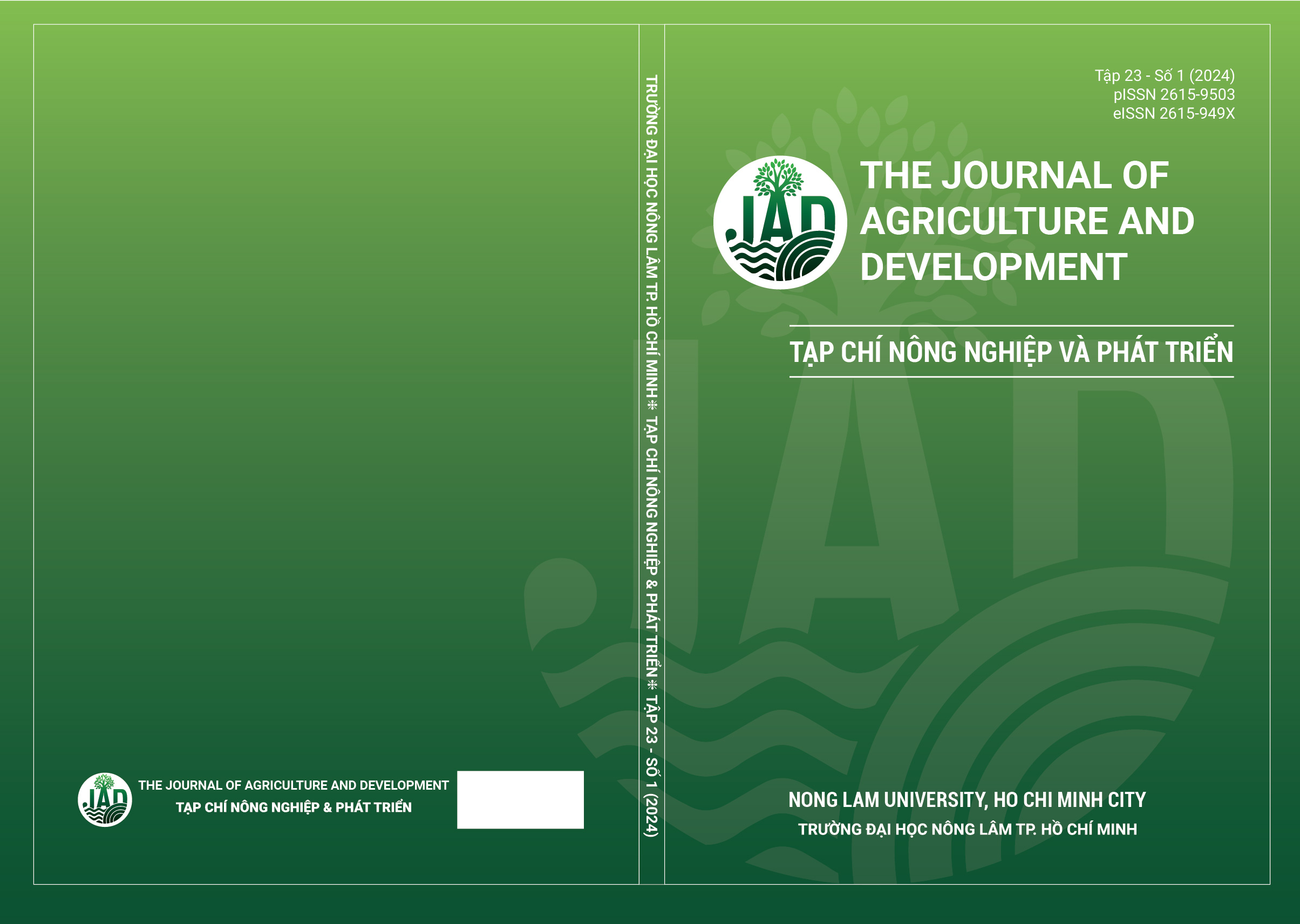
Trích dẫn
Nguyễn, M. T. T., Hoàng, L., Nguyễn, Đoan N. Q., & Hoàng, K. (2024). Kết quả chọn tạo và khảo nghiệm các giống sắn triển vọng KM568, KM539, KM537 tại tỉnh Phú Yên. Tạp Chí Nông nghiệp Và Phát triển 23 (1), 1-13.
Số tạp chí
Chuyên mục
Nông học, Lâm Nghiệp
Main Article Content
Tóm tắt
Nghiên cứu chọn tạo giống sắn năng suất tinh bột cao, kháng được sâu bệnh chính, phù hợp với điều kiện sản xuất của tỉnh Phú Yên là quan trọng và cấp bách. Mục tiêu nhằm chọn tạo được giống sắn có năng suất tinh bột cao (vượt hơn đối chứng KM419 và KM94 tối thiểu 10%), kháng được sâu bệnh chính, điểm bệnh cấp 1 – 2 đối với bệnh khảm lá (CMD) và bệnh chồi rồng (CWBD). Phương pháp nghiên cứu thực hiện theo chuẩn của Chương trình sắn Việt Nam và Trung tâm Nông nghiệp Nhiệt đới quốc tế (CIAT) về quy trình công nghệ chọn tạo và nhân giống sắn lai. Kết quả đã tuyển chọn được ba giống sắn triển vọng KM568, KM539 và KM537. Giống sắn KM568 con lai của KM440 x (KM419 x KM539), có năng suất củ tươi 54 tấn/ha với hàm lượng tinh bột 28,4% lúc 10 tháng sau trồng. Giống sắn KM539 là C39* chọn lọc của C39 nhập nội từ CIAT và có năng suất củ tươi 45,9 tấn/ha với hàm lượng tinh bột 27,9%. Giống sắn KM537 là con lai của (KM419 x KM539) x KM440, có năng suất củ tươi 51,3 tấn/ha với hàm lượng tinh bột 28,5%. Cả 3 giống này đều kháng bệnh CMD cấp 1,5 và kháng bệnh CWBD cấp 1. KM568, KM539 và KM537 lần lượt có 8 – 14 củ/bụi, 7 – 12 củ/bụi và 7 – 12 củ/bụi. Tất cả các giống này đều đạt kiểu hình cây lý tưởng, thịt củ trắng, cây thẳng, tán gọn, lóng ngắn và ít phân cành. Ngoài ra, chiều cao cây của KM568, KM539 và KM537 lần lượt là 2,3 – 2,7 m, 2,7 – 3,0 m và 2,5 – 2,9 m.
Từ khóa: DUS và VCU, Giống sắn, KM568, KM539, KM537
Article Details
Tài liệu tham khảo
FAO (Food and Agriculture Organization of the United Nations). (2022). FAOSTAT. Rome, Italy: FAO.
Hoang, K. (2003). Technology of cassava breeding. In Ngo, D. T., & Le, Q. H. (Eds.). Varietal technology of plant, animal and forestry (Vol. 2, 95-108). Ha Noi, Vietnam: Agricultural Publishing House.
Hoang, K., Nguyen, B. V., Hoang, L., Nguyen, H. T., Ceballos, H., & Howeler, R. H. (2010). Current situation of cassava in Vietnam. In Howeler, R. H. (Ed.), Proceedings of The 8th Regional Workshop on A New Future for Cassava in Asia: Its Use as Food, Feed, and Fuel to Benefit The Poor (100-112). Vientiane, Lao PDR: International Center for Tropical Agriculture (CIAT) and the National Agriculture and Forestry Research Institute (NAFRI). Retrieved February 15, 2022, from http://ciat-library.ciat.cgiar.org/Articulos_Ciat/biblioteca/A_new_future_for_Cassava_in_Asia_Its_use_a_food_freed_and_fuel_to_benefit_the_poor-compressed.pdf.
Hoang, K., Nguyen, M. T. T., Nguyen, M. B., & Howeler, R. H. (2011). Cassava conservation and sustainable development in Vietnam. In Howeler, R. H. (Ed.), Proceedings of The 9th Regional Workshop on Sustainable Cassava Production in Asia for Multiple Uses and for Multiple Markets (35-56). Guangxi, China: International Center for Tropical Agriculture (CIAT) and the Chinese Cassava Agrotechnology Research System (CCARS). Retrieved April 20, 2022, from http://ciatlibrary.ciat.cgiar.org/Articulos_Ciat/biblioteca/Sustainable_cassava_production_in_Asia_for_multiple_uses_and_for_multiple_markets.pdf
Hoang, L., Nguyen, M. T. T., Nguyen, M. B., Hoang, K., Ishitani, M., & Howeler, R. H. (2014). Cassava in Vietnam: production and research; an overview. In Howeler, R. H. (Ed.), Proceedings of Asia Cassava Research Workshop (15). Ha Noi, Vietnam: ILCMB- CIAT-VAAS/AGI.
Howeler, R. H. (2011). Proceedings of the 9th regional workshop on sustainable cassava production in Asia for multiple uses and for multiple markets. Retrieved April 20, 2022, from http://ciatlibrary.ciat.cgiar.org/Articulos_Ciat/biblioteca/Sustainable_cassava_production_in_Asia_for_multiple_uses_and_for_multiple_markets.pdf
Howeler, R. H., & Aye, T. M. (2014). Sustainable management of cassava in Asia – From research to practice. Ha Noi, Vietnam: News Publishing House.
MARD (Ministry of Agriculture and Rural Development). (2022). Report on production situation and directing the prevention of harmful organisms on cassava. Gia Lai, Vietnam: MARD and People’s Committee of Gia Lai Province.
Nguyen, M. B. (2018). Research on cultural techniques to scatter harvest season for cassava in Dak Lak province (Unpublished doctoral dissertation). Tay Nguyen University, Dak Lak, Vietnam.
Nguyen, M. T. T. (2017). Study on the selection of high yielding cassava varieties and intensive cultivation techniques in Phu Yen province (Unpublished doctoral dissertation). University of Agriculture and Forestry, Hue University, Hue, Vietnam.
Nguyen, M. T. T., Hoang, L., Nguyen, D. N. Q., & Hoang, K. (2021). Phu Yen cassava solutions for sustainable development. Phu Yen, Vietnam: Phu Yen Provincial People’s Committee.
Nguyen, V. A., Le, T. N., Nguyen, H., Do, T. T., Nguyen, H. T., Pham, H. T. T., Nguyen, H. T., Seki, M., & Le, H. H. (2021). Characterization of some popular cassava varieties in Vietnam. Journal of Vietnam Agricultural Science and Technology 3(124), 1-17.
Tran, Q. N., Hoang, K., Vo, T. V., & Kawano, K. (1995). Selection results of the new cassava varieties KM60, KM94, KM95 and SM937-26. In Proceedings of Vietnam Agricultural Research Workshop. Lam Dong, Vietnam: Ministry of Agriculture and Rural Development.
VNA (Vietnam National Assembly). (2018). Law No. 31/2018/QH14 dated on November 19, 2018. Law on crop production. Retrieved May 24, 2022, from https://thuvienphapluat.vn/van-ban/Linh-vuc-khac/Luat-Trong-trot-2018-336355.aspx.
VNFU (Central Vietnam Farmer’s Union). (2021). New rural magazine – Farmer’s scientist links take off together. Ho Chi Minh City, Vietnam: Youth Publishing House.

CÂY LƯƠNG THỰC VIỆT NAM
#cltvn #Vietcassava tích hợp thông tin Phú Yên Online I Kết quả bước đầu trong chọn tạo giống sắn kháng bệnh xem tiếp tin và ảnh tại https://baophuyen.vn/79/310545/ket-qua-buoc-dau-trong-chon-tao-giong-san-moi-khang-benh.html
Đề tài khoa học, công nghệ cấp tỉnh “Nghiên cứu chọn tạo giống sắn năng suất tinh bột cao, kháng được sâu bệnh hại chính, phù hợp với điều kiện sản xuất tại tỉnh Phú Yên” đang nhận được sự quan tâm của ngành Nông nghiệp, hộ dân trồng sắn và mở ra nhiều triển vọng cho cây sắn Phú Yên.
Đài Truyền Hình Phú Yên Khoa học và Cuộc sống tháng 11/2023 “Nghiên cứu chọn tạo giống sắn năng suất tinh bột cao, kháng được sâu bệnh hại chính, phù hợp với điều kiện sản xuất tại tỉnh Phú Yên” https://youtu.be/gZZk9OL_4fg

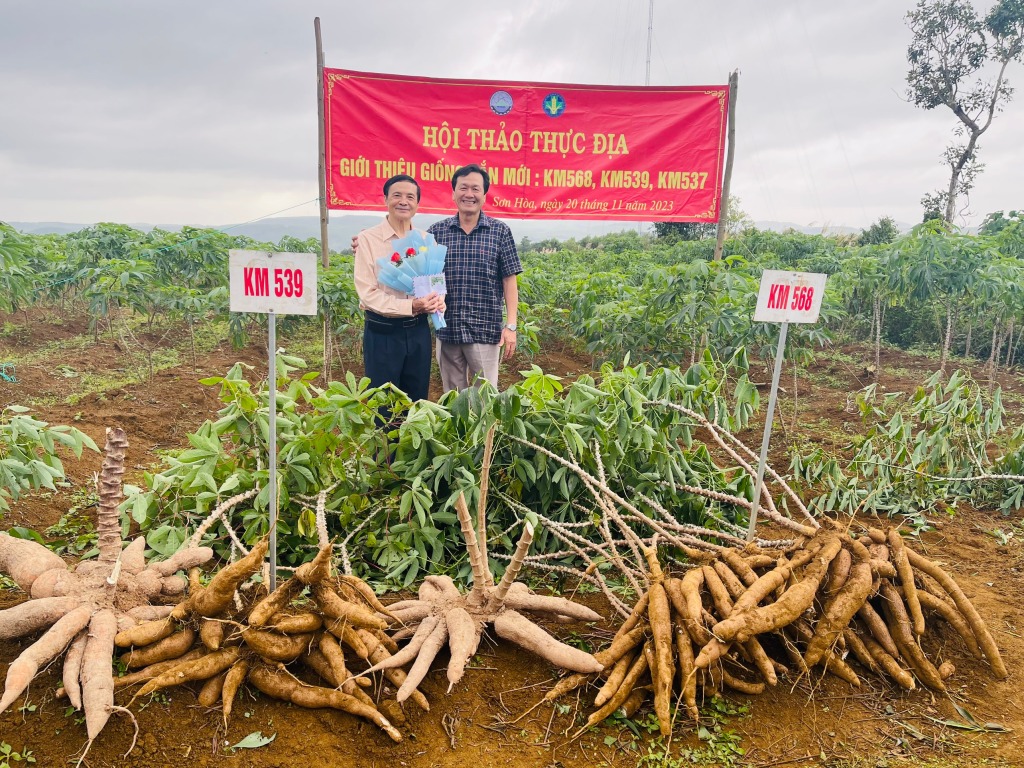
#Vietcassava Sắn Việt Nam ngày nay
Lời tri ân Viện Trường quý thầy cô người thân bà con nông dân và bạn hữu nhân Ngày Nhà giáo Việt Nam: “Bao năm Trường Viện là nhà. Lúa ngô khoai sắn đều là thịt xương. Một đời người một rừng cây. Thầy ươm giống tốt để mai thành rừng”


#Vietcassava Phu Yen 18 11 2023
KM568 năng suất tinh bột cao kháng cao CMD CWBD cây và cũ kiểu hình lý tưởng

KM569 ăn ngon ruột vàng kháng khá CMD CWBD với KM568 năng suất tinh bột cao kháng cao CMD CWBD củ và cây chuẩn được lão Nông chấp nhận tuyển chọn

KM539 năng suất bột cao kháng cao CMD CWBD tuyển chọn dạng cây thấp ít phân nhánh

Giống sắn HN1 năng suất tinh bột cao, kháng cao CMD CWBD nhưng nhược điểm cao cây dễ đổ ngã

SẮN VIỆT NAM VÀ HOWELER
Hoàng Kim
Sắn Việt Nam và Reinhardt Howeler là bài học lớn. Nhà khoa học danh tiếng này là người bạn lớn của nông dân trồng sắn Thế giới, châu Á và Việt Nam. Ông đã dành trọn đời mình cho cây sắn, đúc kết trên 15 sách sắn chuyên khảo. Bạn tốt khó tìm, khó bỏ lại, và không thể quên lãng (Good friends are hard to find, harder to leave, and impossible to forget) see more xem tiếp. https://hoangkimlong.wordpress.com/category/san-viet-nam-va-howeler/ — với Reinhardt Howeler.


Banyat Vankeaw Greate picture of Dr.Howeler from Dr.Kim. We never see picture like this form him, and most of his pictue only with cassava.
Nhiều vấn đề nông nghiệp Brazil đang được tỉnh táo nhìn lại sau 500 năm, gợi cho Việt Nam những góc nhìn tham chiếu về bảo tồn và phát triển nông nghiệp bền vững. Đó là “Kiệt tác của tâm hồn”.
Thật may mắn khi gặp được kiệt tác của tâm hồn khai mở hạnh phúc lòng ta tỉnh lặng và yêu thương hơn.

Con Đường Sắn Việt Nam
Sắn Việt Nam và Howeler

Reinhardt Howeler Thanks Khun Banyat. This picture was taken about two years ago when I went to visit Dr. Hershey at his house in Pensylvania. We went on a short boat ride. Great fun! Being retired since 2009, life is now very relaxing. Unfortunately, no cassava in California.
Kim Hoàng Respectfully greet Professor Reinhardt Howeler
Greetings from Hoang Kim Vietnam and Vietnamese friends. We are Vietnamese, our heads are in the Vietnamese sky, our feet are in the Vietnamese land, our souls are windy with success and Vietnamese culture. It is truly respectful and imitating the humanitarian hearts for the people like Him, like Dr. Kazuo Kawano, like A.Yersin, like Norman Borlaug. Those are great lessons. Lifelong lessons.
The Teacher’s words are very profound: “In life, a person must at least eat, followed by study, work, housing, clothing and health care. There are many unhappy lives around us. The danger of poverty still flares up at any time. Always remember that”; “Reach for the stars. Even if we can’t touch it, if we try our best, we can at least touch the dust particles of the star”; “The main things in human life are only a few. Concentrate and don’t worry about God’s problems. Blessed to spend a lifetime doing good deeds. The legacy will always shine forever.” https://hoangkimlong.wordpress.com/category/san-viet-dat-ong-hoang/ and https://hoangkimlong.wordpress.com/category/loi-thay-dan-thung-dung/
Cach Cach Nguyen So nice to see Dr. Howeler – great friends and cassava teacher of me and famers in the World
CHUYỂN MÙA
Đông tàn, xuân đến tiếp sau
Ngẫm xem thế sự, thấm đau nhân tình
Người lành ưa thích lặng thinh
Đồng xuân, đường sáng, giữ mình #annhiên
Thầy tôi đúng một người hiền
Du sơn ngoạn thủy, thiện lành #thungdung
Đời Người bia miệng anh linh
Trong lòng dân chúng, ân tình nước non.
Thời thầy em, ít doanh nhân
Dấn thân người lính, mình gần yêu thương
Ngày nay thương trường chiến trường
Vẫn là dân quý con đường ấm no
Best wish regards to Reinhardt Howeler. (Reinhardt is traveling through the mountains and water with his close friends). see more Đời Doanh Nhân Trần Tiến và https://hoangkimlong.wordpress.com/category/san-viet-nam-va-howeler/
Older information

Tay Ninh Cassava Workshop 04-08 October 2023 Establishing Sustainable Solution to Cassava Disease in Mainland Southeast Asia. Project Review and Research Symposium, see more Vietnamese cassava today https://hoangkimlong.wordpress.com/category/vietnamese-cassava-today/
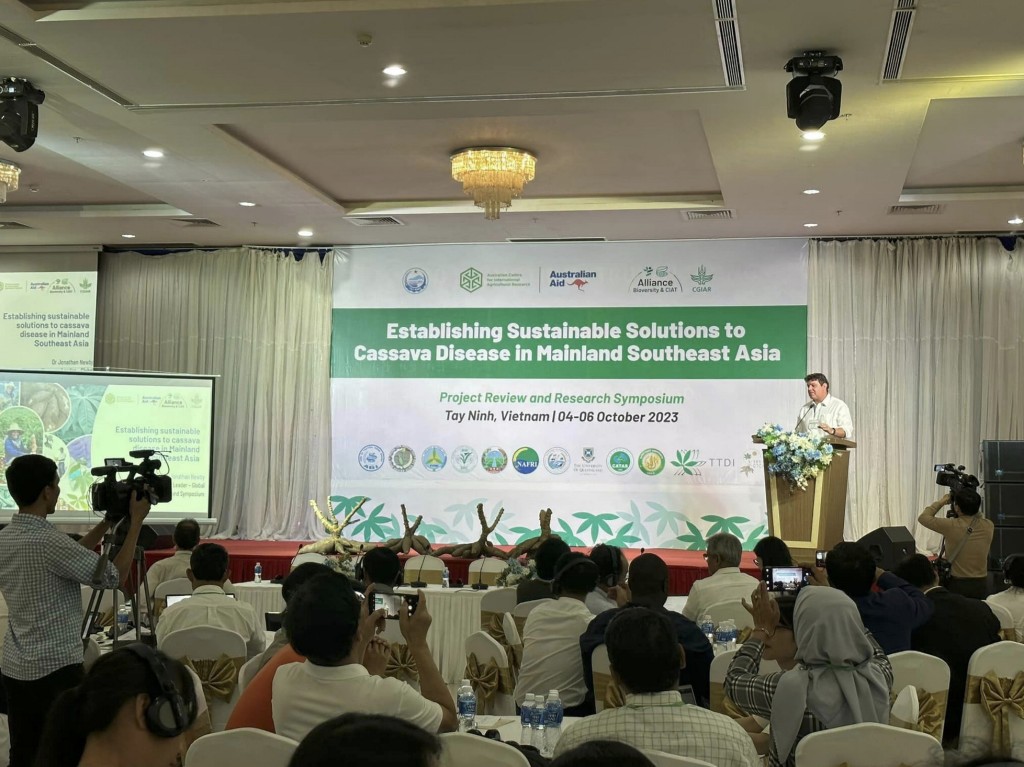
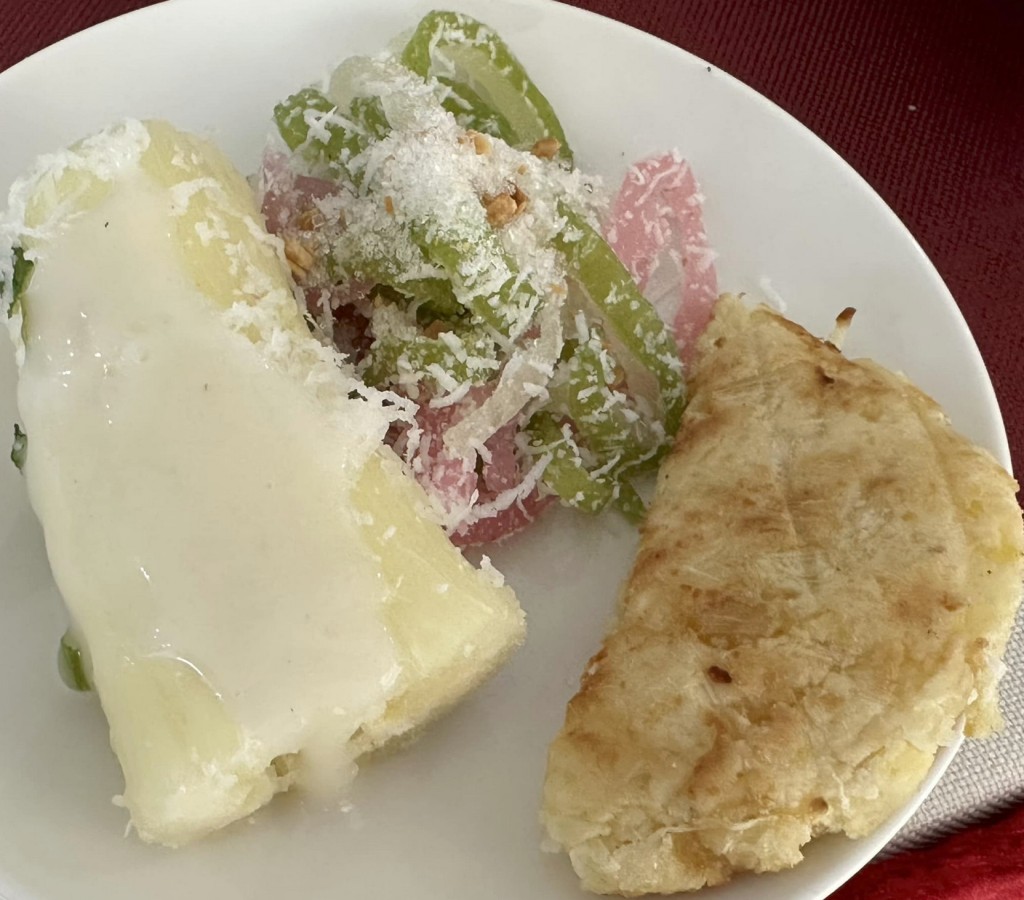

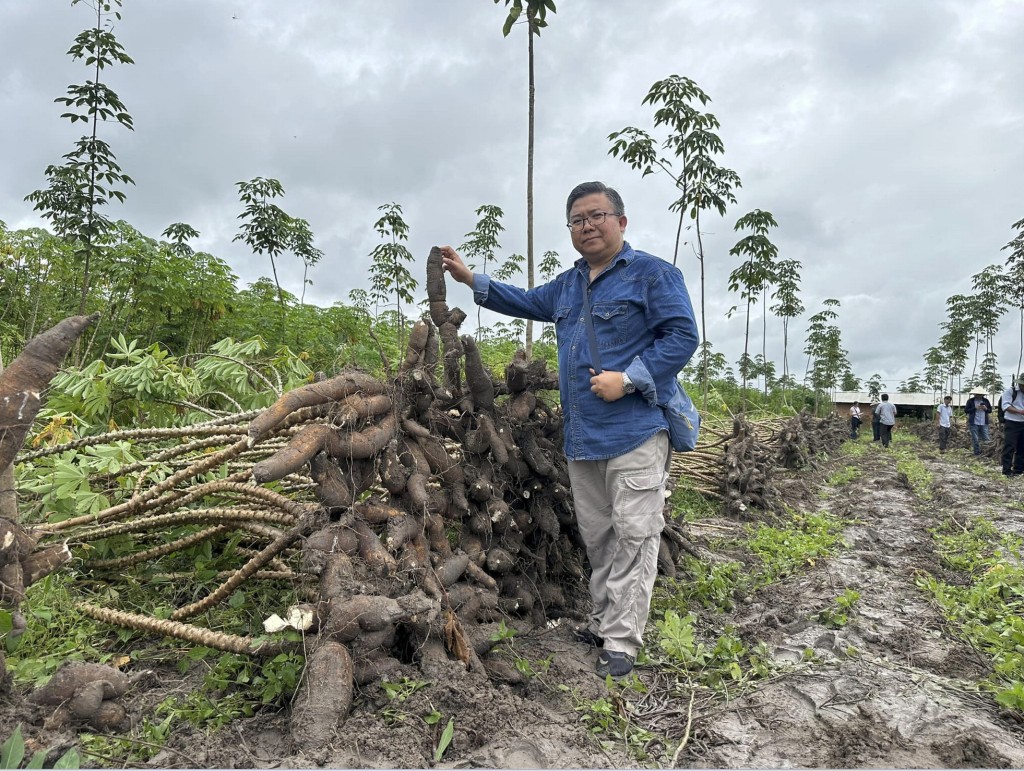



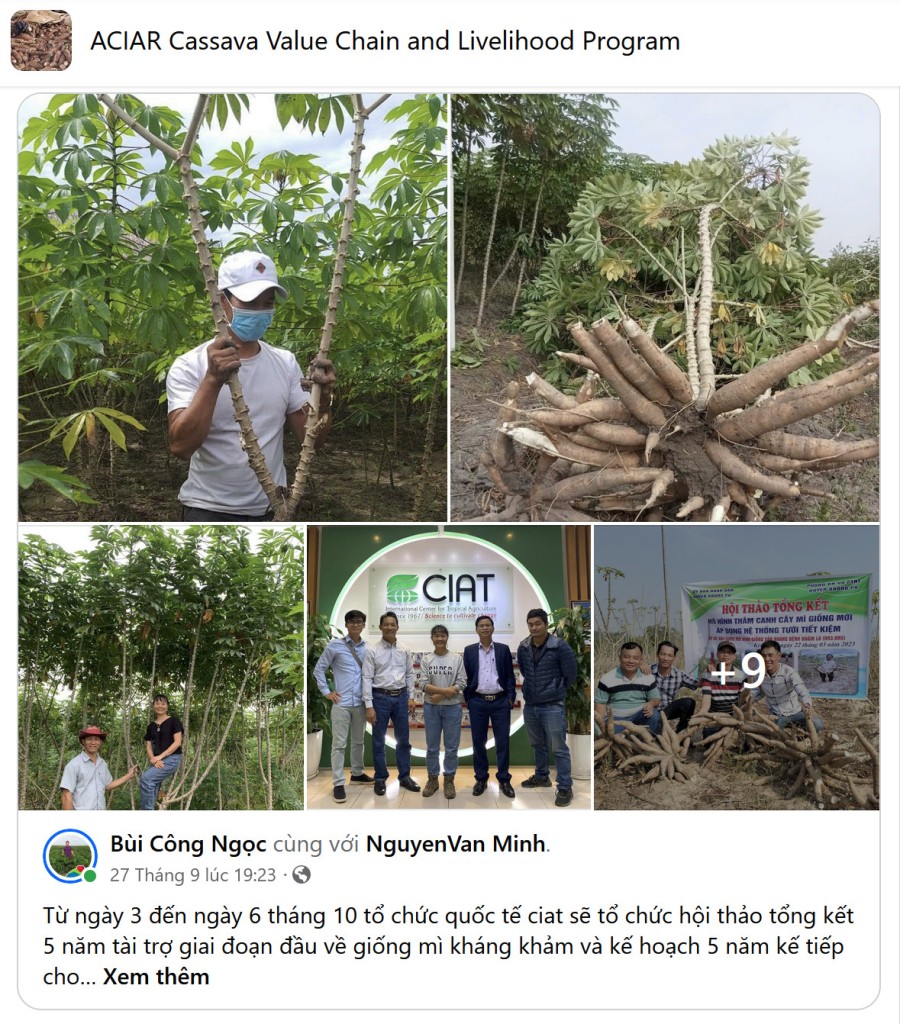
Dự án thiết lập các giải pháp bền vững xử lý sâu bệnh hại khoai mì khu vực Đông Nam Á:
Chọn tạo được 6 giống mì kháng bệnh khảm lá Cập nhật ngày: 05/10/2023 – 08:38
BTNO – Sáng 4.10, UBND tỉnh Tây Ninh tổ chức hội nghị tổng kết Dự án thiết lập các giải pháp bền vững xử lý sâu bệnh hại khoai mì (sắn) khu vực Đông Nam Á.
(Nguồn: Báo Tây Ninh: https://baotayninh.vn/chon-tao-duoc-6-giong-mi-khang-benh-kham-la-a164224.html) tích hợp thông tin tại Vietnamese cassava today https://hoangkimlong.wordpress.com/category/vietnamese-cassava-today/

Ông Trần Văn Chiến – Phó Chủ tịch UBND tỉnh phát biểu tại hội nghị.
Dự hội nghị có ông Lê Văn Thiệt- Phó Cục trưởng Cục Bảo vệ thực vật; ông Trịnh Xuân Hoạt- Phó Viện trưởng Viện Di truyền thuộc Bộ Nông nghiệp và Phát triển nông thôn (NN&PTNT); đại diện Trung tâm Nghiên cứu Nông nghiệp quốc tế Úc (ACIAR), đơn vị tài trợ dự án; Trung tâm Nông nghiệp Nhiệt đới Quốc tế (CIAT), chuyên gia nông nghiệp các nước Campuchia, Lào, Indonesia, Philippines, và một quốc gia châu Phi.
Về phía Tây Ninh có ông Trần Văn Chiến- Phó Chủ tịch UBND tỉnh; ông Nguyễn Đình Xuân – Giám đốc Sở NN&PTNT và nông dân trồng mì trên địa bàn tỉnh.
Phát biểu tại hội nghị, Phó Chủ tịch UBND tỉnh Trần Văn Chiến cho biết, dự án Thiết lập các giải pháp xử lý bệnh hại trên cây mì tại các nước khu vực Đông Nam Á do ACIAR tài trợ, thực hiện trong giai đoạn 2019 – 2023, có sự tham gia của Trung tâm Nghiên cứu thực nghiệm nông nghiệp Hưng Lộc, Viện Di truyền nông nghiệp, Viện Bảo vệ thực vật và Sở NN&PTNT Tây Ninh. Dự án nghiên cứu, khảo nghiệm và đánh giá một số giống mì tiềm năng có khả năng kháng bệnh phù hợp với điều kiện tự nhiên của khu vực Đông Nam bộ. Kết quả bước đầu của dự án chọn tạo được 6 giống mì kháng bệnh khảm lá, gồm: HN1, HN3, HN5, HN36, HN80, HN97.
Ông Trần Văn Chiến hy vọng trong thời gian tới, Trung tâm ACIAR và CIAT sẽ tiếp tục hỗ trợ nghiên cứu và phát triển lĩnh vực nông nghiệp nông thôn trên địa bàn tỉnh; đồng thời, phối hợp triển khai có hiệu quả trong lĩnh vực nghiên cứu, lai tạo, trồng khảo nghiệm và sản xuất các giống mì mới sạch bệnh cho năng suất, hàm lượng tinh bột cao, có khả năng thích ứng tốt với điều kiện canh tác tại Tây Ninh.

Ông Jonathan Newby – Giám đốc Chương trình sắn Quốc tế, Trung tâm Nông nghiệp Nhiệt đới Quốc tế (CIAT) trao đổi với ông Bùi Công Ngọc-(người được chuyển giao thí điểm nhân giống mì kháng khảm).
Ông Nguyễn Đình Xuân – Giám đốc Sở NN&PTNT Tây Ninh cho biết, diện tích trồng mì hàng năm của tỉnh khoảng 60.000 ha, tập trung tại các huyện Tân Châu, Tân Biên, Châu Thành và Dương Minh Châu. Năng suất trung bình từ 33 – 35 tấn/ha (cao gấp 1,7 lần năng suất trung bình của cả nước), chiếm 10% diện tích và 20% tổng sản lượng, đóng góp 50% vào tổng thu nhập quốc gia.
Theo ông Xuân, bệnh khảm lá đã ảnh hưởng đáng kể đến năng suất tinh bột mì, từ 30% -70%. Do đó, việc triển khai dự án thiết lập các giải pháp bền vững xử lý sâu bệnh hại mì khu vực Đông Nam Á giúp tìm ra được nhiều giống mới, kháng được bệnh, năng suất cao hơn đáng kể so với các giống được trồng phổ biến trước đây.
Ông Jonathan Newby- Giám đốc Chương trình sắn quốc tế, Trung tâm CIAT cho biết, kết quả dự án cho thấy việc trồng trọt bằng nguồn giống sạch sẽ cho năng suất củ tươi và hàm lượng tinh bột cao hơn đáng kể đối với tất cả các giống được thử nghiệm. “Chúng tôi đang trong giai đoạn đàm phán cuối cùng để thành lập Trung tâm Nghiên cứu sắn ở tỉnh Tây Ninh, có sự tham gia của nhà nước, doanh nghiệp và các nhà đầu tư nghiên cứu”- ông Jonathan Newby nói thêm.

Nông dân tham gia khảo sát bất ngờ về bộ củ của cây mì HN1.
Tại hội nghị, UBND tỉnh ký kết biên bản thoả thuận hợp tác với Trung tâm Nông nghiệp Nhiệt đới Quốc tế (CIAT) giai đoạn 2024 – 2028. Theo đó, hai bên thống nhất thành lập một ban điều hành bao gồm các thành viên của CIAT, UBND tỉnh Tây Ninh, đại diện của các doanh nghiệp nhằm hỗ trợ và điều phối các hoạt động nghiên cứu tại địa phương trong giai đoạn 2024-2028.
Minh Dương

GIỐNG SÁN TỐT PHÚ YÊN
Các giống sắn mới triển vọng KM568, KM539, KM537, KM569 kết quả chọn tạo và khảo nghiệm tại tỉnh Phú Yên https://hoangkimlong.wordpress.com/category/bao-ton-va-phat-trien-san

Phú Yên bảo tồn và phát triển sắn bền vững, câu chuyện hôi thảo sắn 2021 và một số thông tin mới cập nhật
PHÚ YÊN BẢO TỒN VÀ PHÁT TRIỂN SẮN BỀN VỮNG
Nguyễn Thị Trúc Mai, Hoàng Long, Nguyễn Nữ Quỳnh Đoan, Hoàng Kim
Tham luận trình bày tại Hội nghị Phú Yên 28 12 2021 “Giới thiệu về các công nghệ trong sản xuất Nông Lâm Thủy sản” và tại Hội nghị Phú Yên 31 12 2021 UBND tỉnh Phú Yên “Tổng kết hoạt động khoa học và công nghệ giai đoạn 2016-2020, định hướng phát triển ứng dụng khoa học công nghệ và đổi mới sáng tạo giai đoạn 2021-2025
Tỉnh Phú Yên xác định lúa mía sắn là ba cây trồng chủ lực, lợi thế đầu tư tái cơ cấu theo hướng gia tăng giá trị, sản xuất tập trung, quy mô lớn và bền vững, tầm nhìn đến năm 2030, là trọng điểm chuỗi giá trị về nông sản và nền tảng của an sinh, kinh tế, xã hội địa phương . Nhân dân Phú Yên và hệ thống chính trị xã hội đều năng động, hiệu quả, giỏi nghiên cứu ứng dụng phát triển. Thành tựu hoạt động khoa học và công nghệ 2016-2020 Phú Yên đã đạt được là khảo nghiệm, tuyển chọn và phát triển được giống sắn chủ lực KM419, giống sắn phổ biến KM440, mô hình canh tác sắn thích hợp bền vững, đồng hành với việc chọn tạo và phát triển giống lúa siêu xanh GSR65, giống lúa siêu xanh GSR90 phẩm chất ngon, năng suất cao, thích ứng biến đổi khí hậu. Định hướng phát triển ứng dụng khoa học công nghệ và đổi mới sáng tạo giai đoạn 2021-2025, tỉnh Phú Yên đã lựa chọn giải pháp bảo tồn và phát triển sắn thích hợp bền vững. Đề tài “Nghiên cứu chọn tạo giống sắn năng suất tinh bột cao, kháng được sâu bệnh hại chính, phù hợp với điều kiện sản xuất tại tỉnh Phú Yên.
xem tiếp https://hoangkimlong.wordpress.com/catrgory/bao-ton-va-phat-trien-san
Sắn Việt Nam là câu chuyện nhiều năm còn kể. Gia đình sắn Việt Nam là một kinh nghiệm quý về sự liên kết chặt chẽ giữa các ‘bạn nhà nông’ chuyên gia nông học, thầy giáo cán bộ nghiên cứu sinh viên, các chuyên gia quốc tế cùng làm việc chặt chẽ với nông dân xây dựng mô hình điểm trình diễn, đó là chìa khóa cho sự bảo tồn và phát triển. “Chuyện ngậm ngãi tìm trầm” “Sắn Việt đất ông Hoàng” là hai ghi chú nhỏ trong số đó.


Chọn tạo khảo nghiệm và nhân giống là một chuỗi công việc cẩn trọng công phu và nhiều vấn nạn ngày nay. Khảo nghiệm DUS và VCU là một nội dung rất quan trọng, trước khi nhân giống, khảo nghiệm sản xuất, xây dựng mô hình và quy trình canh tác thích hợp cho giống sắn mới. Nội dung khảo nghiêm DUS và VCU giống sắn được thực hiện theo đúng Thông tư Quy định về khảo nghiệm, công nhận giống cây trồng nông nghiệp mới của Bộ Nông nghiệp và Phát triển Nông thôn, thi hành Luật Trồng trọt (Quốc Hội 31/2018, hiệu lực thi hành 1.1.2020), để tránh nhân giống sớm những giống sắn chưa được kiểm định nghiêm ngặt và chưa đủ thông tin tự công bố giống, tránh gây thiệt hại cho sự đầu tư của nông dân, doanh nghiệp và chuỗi giá trị sản xuất chế biến kinh doanh sắn.



Fwd: FOOD CROPS: Current situation of cassava in Vietnam and the breeding of improved cultivars
Từ: hoangkim vietnam <hoangkim.vietnam@gmail.com>
Ngày: 20 thg 9, 2023 lúc 04:19
Chủ đề: Re: FOOD CROPS: Current situation of cassava in Vietnam and the breeding of improved cultivars
Tới: CLAIR HERSHEY <clair.hershey@gmail.com>
CC: <hoangkim@hcmuaf.edu.vn>, <hoangkim_vietnam@yahoo.com>Inbox
Dear Clair Hershey .This is interesting. Thank you very much for your information. We will sending to you soon. Best wish regard. Your sincerely. Hoang Kim
Vào Thứ 4, 20 thg 9, 2023 lúc 00:33 CLAIR HERSHEY <clair.hershey@gmail.com> đã viết:
Dear Hoang Kim,
It has been quite a long time since we have been in contact. I hope you are doing very well. I see your occasional posts on Facebook and elsewhere, and continued work on cassava.
I retired from CIAT in 2016, but continue to collaborate with them on some projects. Currently I am writing a history of the CIAT cassava genebank since its first establishment in 1969.
One of the topics included in the report is the cassava core collection. I am trying to gather information about all the evaluations done on the core collection.
In my searches, I came across the paper you and colleagues wrote, and re-published as a blog spot in 2010, which I have attached here.
I note that in the paragraph just before Table 8, you refer to evaluating cassava varieties for ethanol production from the CIAT core collection that is held in Vietnam. It seems that the current CIAT staff in Asia does not have information about this. Can you please possibly provide me with a few details? Did you introduce the core collection from CIAT Colombia or from Thailand? Is the evaluation data available in any publication?
Thank you very much in advance for any information about this. I will appreciate it very much.
With very best wishes,
http://foodcrops.blogspot.com/2010/05/current-situation-of-cassava-in-vietnam.html
see more: https://hoangkimlong.wordpress.com/category/bao-ton-va-phat-trien-san/ and https://cnm365-wordpress,com/category/cnm365-cltvn-20-thang-9
H

Giống sắn KM419 và KM440,
nền tảng bảo tồn và phát triển
Kết quả nâng cấp cải tiến giống sắn chủ lực thương mại KM419, KM440 bằng cách hồi giao với KM539, KM537, KM534, KM94 thuộc nhiệm vụ khoa học thực tiễn cấp bách: ”Nghiên cứu chọn tạo giống sắn năng suất tinh bột cao, kháng được sâu bệnh hại chính, phù hợp với điều kiện sản xuất tại tỉnh Phú Yên. Giống sắn KM568 trên ruông nông dân Phú Yên (giữa) rất sạch bệnh khảm lá virus (CMD) và bệnh chồi rồng CWBD, bên trái phía sau là giống sắn chủ lực sản xuất KM419 cũ nhiều và đồng đều nhưng nhiễm bệnh CMD mức 3,5; bên phải phía sau là giống chủ lực thương mại KM440 kháng bệnh CMD cấp 2, CWBD cấp 1,5. Giống sắn KM568, KM440 năng suất tinh bột cao, kháng được sâu bệnh hại chính, phù hợp với điều kiện sản xuất của tỉnh Phú Yên; xem tiếp Bảo tồn và phát triển sắn https://hoangkimlong.wordpress.com/category/bao-ton-va-phat-trien-san/



Giống sắn KM 419 được chọn tạo từ tổ hợp lai BKA900 x KM 98-5. Giống do Trường Đại học Nông Lâm Thành phố Hồ Chí Minh phối hợp với Trường Đại học Nông Lâm Thái Nguyên, Sở Nông nghiệp và Phát triển Nông thôn Phú Yên, Trường Đại học Nông Lâm Huế tuyển chọn và giới thiệu (Hoàng Kim, Trần Ngọc Ngoạn, Nguyễn Thị Trúc Mai, Võ Văn Quang, Nguyễn Bạch Mai, Nguyễn Thị Lệ Dung, Nguyễn Phương, Hoàng Long, Nguyễn Minh Cường, Đào Trọng Tuấn, Trần Công Khanh, Nguyễn Minh Hiếu, Nguyễn Văn Bộ, Nguyễn Thị Cách, Nguyễn Trọng Hiển, Lê Huy Ham, H. Ceballos and M. Ishitani. (2016), Giống sắn KM419 đượcBộ Nông nghiệp và Phát triển Nông thôn công nhận sản xuất thử tại Quyết định số 85 / QĐ-BNN-TT Hà Nội ngày 13 tháng 1 năm 2016 cho vùng sinh thái Bắc Trung Bộ, Duyên hải Nam Trung Bộ, Tây Nguyên, Đông Nam Bộ).
Giống sắn KM419 là giống sắn chủ lực của Việt Nam có diện tích thu hoạch năm 2016 chiếm 38 % so với giống sắn KM94 chiếm 31,7% (RTB Newsletter 2016. Assessment reveals that most cassava grown in Vietnam has a CIAT pedigree), và từ năm 2019 giống sắn KM419 chiếm trên 42% tổng diện tích sắn toàn Việt Nam.

Giống KM419 có đặc điểm:
+ Thân xanh xám thẳng, ngọn xanh cọng đỏ, lá xanh đậm, không phân nhánh.
+ Năng suất củ tươi: 34,9-54,9 tấn/ha.
+ Tỷ lệ chất khô: 35,1- 39.0%.
+ Hàm lượng tinh bột: 27,8 – 30,7%.
+ Năng suất tinh bột: 10,1-15,8 tấn/ ha
+ Chỉ số thu hoạch: 62 %.
+ Thời gian thu hoạch: 7-10 tháng.
+ Nhiễm trung bình bệnh chồi rồng và bệnh khảm lá virus CMD
+ Cây cao vừa, nhặt mắt, tán gọn, thích hợp trồng mật độ dày 12,500- 14.000 gốc/ ha .
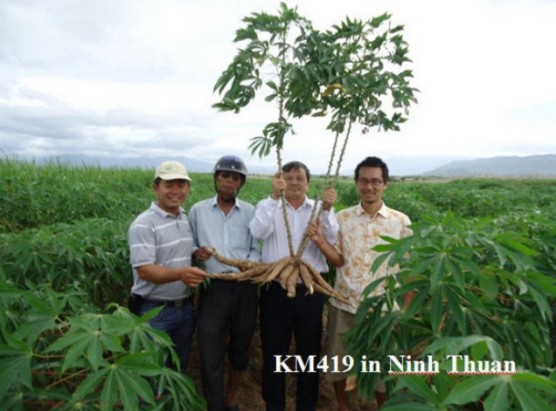
Giống sắn KM419 đã phát triển rộng rãi tại Tây Ninh, Đồng Nai, Đắk Lắk, Phú Yên,…được nông dân các địa phương ưa chuộng với tên gọi sắn giống cao sản siêu bột Nông Lâm. Đặc biệt tại tỉnh Phú Yên giống sắn KM419 được trồng trên 85% tổng diện tích sắn của toàn tỉnh mang lại bội thu năng suất và hiệu quả cao về kinh tế xã hội. Tại Tây Ninh, năm 2019 diện tích sắn bị nhiễm bệnh CMD tuy vẫn còn cao nhưng mức độ hại giảm mạnh, lý do vì KM419 và KM94 là giống chủ lực chiếm trên 76% diện tích mỗi vụ của toàn tỉnh (KM419 chiếm 45% ở vụ Đông Xuân và 54,2% ở vụ Hè Thu; KM94 chiếm 31% ở vụ Đông Xuân và 21,6% ở vụ Hè Thu). Tại Đăk Lắk, năm 2019 diện tích sắn KM419 chiếm trên 70% diện tích mỗi vụ của toàn tỉnh
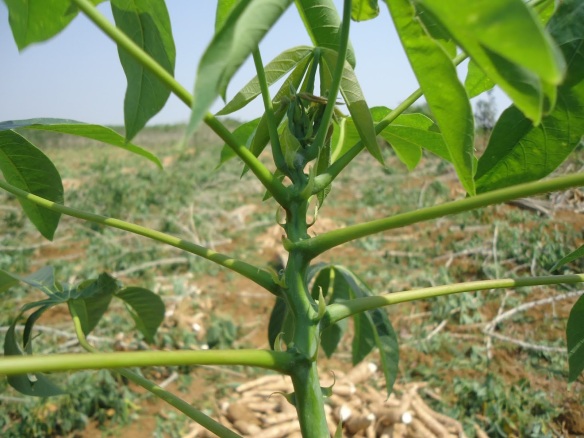
Đặc điểm giống sắn KM440 thân xanh, thẳng, nhặt mắt, không phân cành, lá già xanh đậm, đọt non màu xanh tím, củ đồng đều, dạng củ đẹp, thịt củ màu trắng, ít nhiễm sâu bệnh, năng suất củ tươi 40,5 đến 53,1 tấn/ha. Hàm lượng bột đạt từ 27,0 -28,9%,. giống ngắn ngày, thời gian giữ bột sớm hơn KM94.
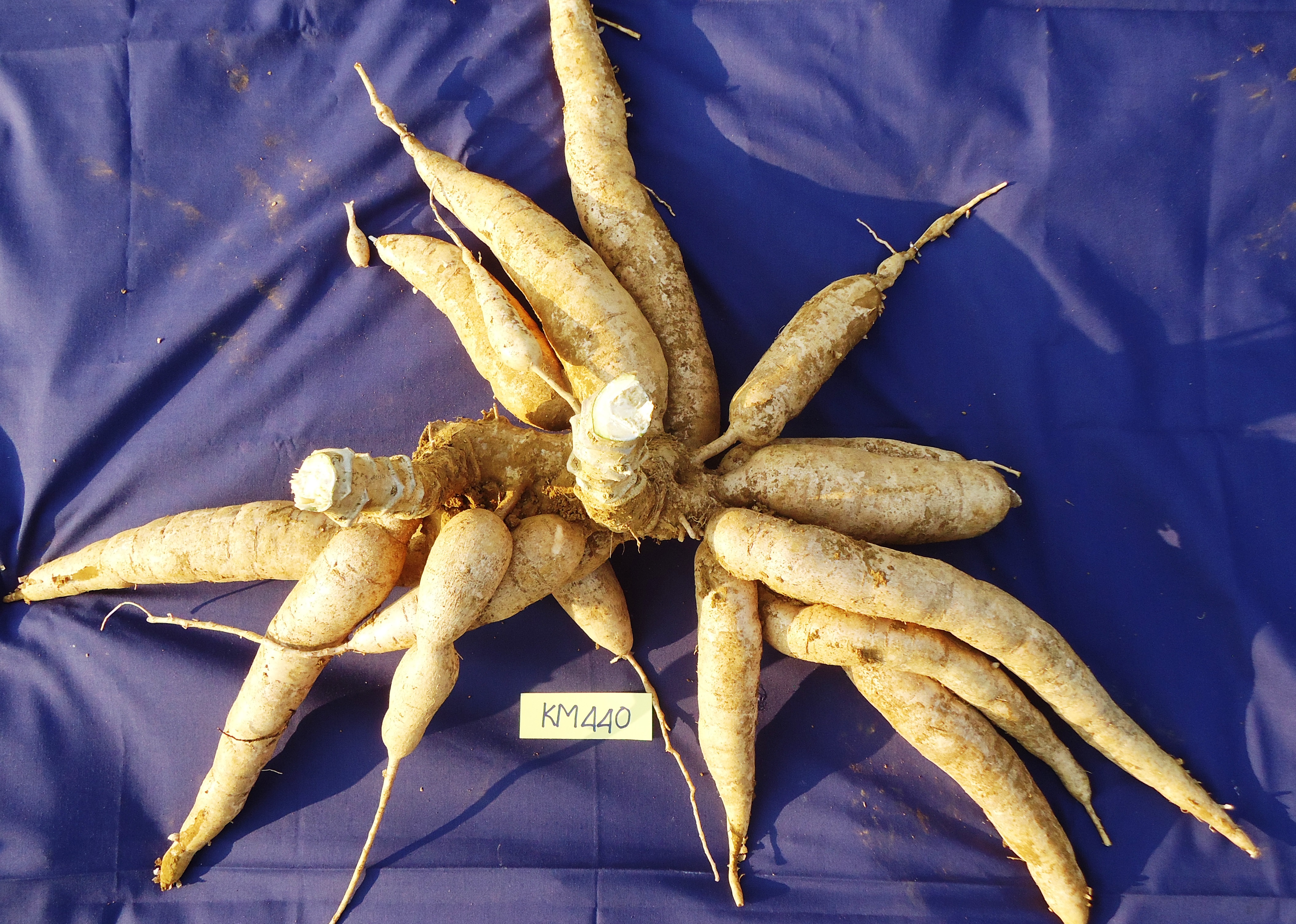

PHÚ YÊN NÔI LÚA SẮN
Hoàng Kim
Thông tin Sở Khoa học và Công nghệ Phú Yên, Hội nghị tổng kết hoạt động khoa học và công nghệ Phú Yên giai đoạn 2016-2020; Định hướng phát triển, ứng dụng khoa học, công nghệ và đổi mới sáng tạo giai đoạn 2021-2025. Sáng ngày 31/12/2021, tại TP Tuy Hòa, UBND tỉnh Phú Yên đã phối hợp với Sở KH&CN tổ chức hội nghị tổng kết hoạt động khoa học và công nghệ Phú Yên giai đoạn 2016-2020; Định hướng phát triển, ứng dụng khoa học, công nghệ và đổi mới sáng tạo giai đoạn 2021-2025. Hội nghị được tổ chức trực tiếp tại TP Tuy Hòa và kết nối trực tuyến đến các thị xã, huyện trong địa phương cùng đại diện Bộ KH&CN. Chủ trì Hội nghị là đồng chí Đào Mỹ, Phó Chủ Tịch UBND tỉnh Phú Yên và đồng chí Dương Bình Phú, Giám đốc Sở KH&CN, tham dự Hội nghị còn có ông Thân Ngọc Hoàng, Phó Vụ trưởng Vụ Phát triển Khoa học và Công nghệ địa phương và đại diện lãnh đạo các Sở, Ban, Ngành, đơn vị, doanh nghiệp trong tỉnh; xem tiếp https://khcnpy.gov.vn/hoi-nghi-tong-ket-hoat-dong-khoa-hoc-va-cong-nghe-phu-yen-giai-doan-2016-2020-dinh-huong-phat-trien-ung-dung-khoa-hoc-cong-nghe-va-doi-moi-sang-tao-giai-doan-2021-2025/
Phú Yên nôi lúa sắn https://youtu.be/CKdEr4aS2NA là lời biết ơn chân thành bởi Hoàng Kim và đs. 2021. Hoàng Kim tham dự hội nghị theo giấy mời của UBND Tỉnh Phú Yên. Chúng tôi lưu trích đoạn lúa sắn thuộc lĩnh vực kỹ thuật công nghệ trong phim của Đài Phát thanh và Truyền hình Phú Yên với Sở Khoa học và Công nghệ phối hợp thực hiện tháng 12 năm 2021. Phim chiếu tại Hội nghị tổng kết hoạt động khoa học công nghệ giai đoạn 2016-2020, định hướng phát triển ứng dụng KHCN & ĐMST giai đoạn 2021-2025 https://youtu.be/CKdEr4aS2NA

Bảo tồn và phát triển sắn
SẮN PHÚ YÊN GIẢI PHÁP PHÁT TRIỂN BỀN VỮNG
TS. Nguyễn Thị Trúc Mai, TS. Hoàng Kim, TS. Hoàng Long
Báo cáo Phú Yên 28 12 2021 Hội nghị “Giới thiệu về các công nghệ trong sản xuất Nông Lâm Thủy sản”, tài liệu hội nghị và bài tham luận tại Phú Yên 31 12 2021 “Hội nghị Tổng kết hoạt động khoa học và công nghệ giai đoạn 2016- 2020, định hướng phát triển ứng dụng KHCN & ĐMST giai đoạn 2021-2025” UBND Tỉnh Phú Yên,

Tóm tắt: Báo cáo này đề cập ba nội dung: 1) Những vấn đề cần chú ý trong sản xuất sắn hiện nay để nâng cao giá trị và sức cạnh tranh cây sắn; 2) Thành tựu và bài học sắn Việt Nam (2016-2021) trước và trong dịch bệnh sắn CMD và CWBD ; 3) Phú Yên bảo tồn và phát triển sắn bền vững



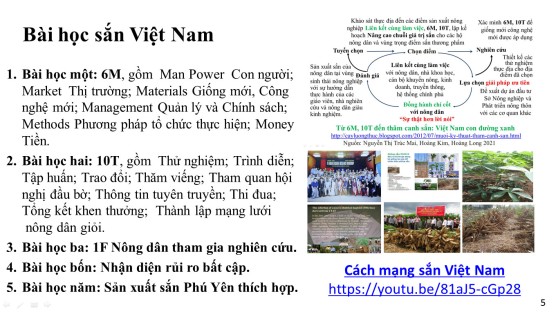







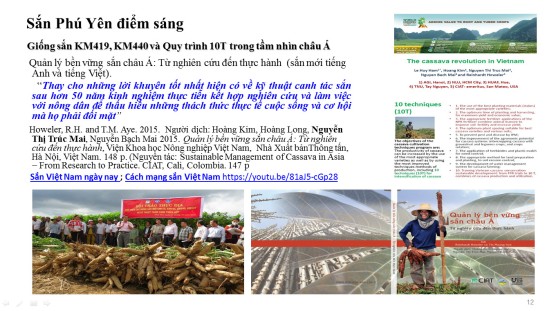






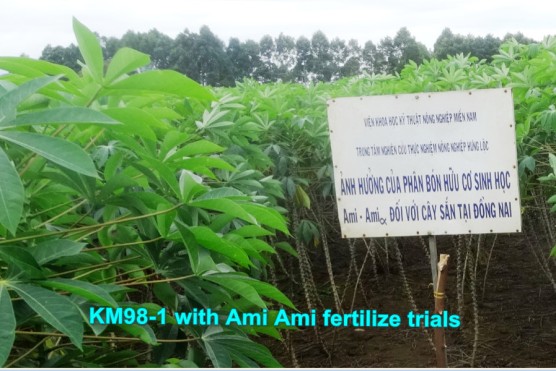
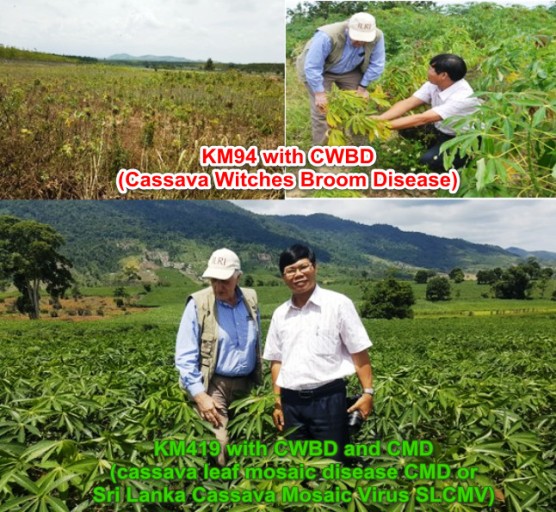
A BRIEF HISTORY OF A SUCCESSFUL BREEDING PROGRAM

As is widely known, Vietnam has accomplished a rapid economic development in recent 20 years. During the same period, , cassava, starting from a low status crop grown by small farmers and consumed as human food by poor people, has grown into a major crop providing raw materials for animal feeding, industrial starch processing and most recently bio-ethanol production (though I have some reservations for using cassava for this purpose), thus bringing precious cash income to millions of small farm families. When I first visited Vietnam in 1988, cassava’s acreage all over the country was 0.28 million ha with mean yield of 8.4 t/ha. It now occupies 0.56 million ha (official figure: the actual figure is said to be around 0.65 million ha; the emphasis of research is gradually shifting from varietal improvement to soil conservation) with 15.9t/ha mean yield. Vietnam has now advanced to World No. 2 exporter of cassava products next only to Thailand.
It is extremely gratifying to witness this progress toward the end of my career; then, what made this experience possible? The breeding work that has brought this result started when I joined CIAT as cassava breeder in 1973, where CIAT was inaugurating an integrated cassava research program with global mandate by recruiting a half dozen of young PhD from world reputable universities. As such, I initiated a comprehensive cassava breeding program using a population which contained a vast genetic variation coming from more than 2000 native varieties collected from the centers of origin and diversification of cassava all over Latin America.
Especially noteworthy in this process is the fact that those countries such as Colombia, Brazil and Mexico where abundant cassava germplasm existed donated to or allowed CIAT to collect native cassava varieties on the condition that the newly established international research center CIAT uses all these germplasm for the welfare of people in the world without pursuing any monetary profit. It goes without saying that those rural small farmers who grew native cassava varieties inherited from their ancestors were very cooperative with the CIAT collection. The researchers as well the early CIAT administration clearly shared the immeasurable importance of basic germplasm in pursuing large scale breeding.
I accomplished much of the basic breeding during the first 10 years at CIAT/Colombia and moved to Thailand in 1983 by opening a CIAT/Asia office on the understanding that the effect of cassava varietal improvement would be more eminent in Asia. Thus, I started a more practical breeding in close collaboration with Thai workers. Here again, we were very thankful that the Colombian government allowed us to transfer cassava breeding materials to Asia without condition. As a result, I had transferred more than 1 million genotypes of cassava, mainly in the form of F1 hybrid seeds, from Latin America to Asia during the 15 years that followed.
This breeding work, based on the hybridizations between Latin American and Thai materials, resulted in a great success and produced many superior varieties. Now, some 97% of the total 1.15million ha of cassava in Thailand is planted with these new varieties we developed. I transferred many advanced breeding materials from Thailand to other Asian countries such as Indonesia, Philippines, China and Vietnam. In this process as well, the Thai government authorization of transferring our breeding materials to other Asian countries, which could well be potential (in fact, actual) competitors to Thailand, was to be highly appreciated.
In 1989, I brought planting stakes of Rayong 60 and Kasetsart 50 among others as a check-in baggage of the Bangkok-Ho Chi Minh flight (The import and plant quarantine permit had been very willingly arranged by the Vietnamese institution). Upon harvesting the first cycle evaluation /multiplication at Hung Loc Center in 1990, I carried the planting stakes of these varieties from HCM to Hanoi to be evaluated and multiplied by the research institutions in the North. In retrospect, my action was rather unorthodox power play. Nevertheless, considering that this was the beginning of a long story which would develop to generating an annual additional economic effect in the order of 200 million US dollars to be shared by the millions of small farmers, power play may be justified on certain critical occasions.
NHỚ BẠN MÙA GIÁNG SINH
Hoàng Kim
Bạn tốt khó tìm, khó bỏ lại và không thể quên lãng. Cách mạng sắn Việt Nam The cassava revolution in Vietnam https://youtu.be/81aJ5-cGp28 là câu chuyện thành công. Sắn Việt Nam ngày nay, https://hoangkimlong.wordpress.com/category/vietnamese-cassava-today/ sự cấp thiết phải Bảo tồn và phát triển sắn bền vững. Lời chào từ HoangKim Vietnam VNCP đến Howeler, Martin với các bạn CIAT, ACIAR “Establishing sustainable solutions to cassava diseases in mainland Southeast Asia”. Chúc mừng Giáng sinh an lành và Năm mới hạnh phúc

Tiến sĩ Reinhardt Howeler quý mến,
Kính chào người Thầy và bạn lớn của nông dân trồng sắn châu Á. Ảnh 1 Hội thảo sắn toàn cầu ở Việt Nam năm 2000, có mặt người vợ yêu quý của Reinhardt Howeler và giáo sư Phạm Văn Biên, Viện trưởng Viện Khoa học Kỹ thuật Nông nghiệp miền Nam. Nay bà đã mất. Hãy cho chúng tôi chia buồn muộn tới bạn. Tôi và VNCP lạc email bạn. Ảnh này là sự ghi ơn thầm lặng trong lòng chúng tôi. Ảnh 2 Tiến sĩ Reinhardt Howeler Tiến sĩ Kazuo Kawano nhận giải thưởng của nhà nước Việt Nam, được trao tặng bởi ông Nguyễn Giới, thứ trưởng MARD, và giáo sư Phạm Văn Biên, Viện trưởng IAS, ngày 4/3/1997. Ảnh 3 là bảy sách sắn CIAT Việt Nam, cuối thế kỷ 20 và đầu thế kỷ 21, ghi nhận những đóng góp nổi bật của các bạn. Ảnh 4 là Luis Eduardo Barona và Hoàng Kim với giống sắn C39 ở CIAT năm 2003 trong sự hợp tác với Hernan Ceballos và Martin Fregene. Ảnh 5 là giống sắn chủ lực KM419 của Sắn Việt Nam ngày nay.
Các bạn luôn trong lòng chúng tôi. Chúng tôi luôn nhớ và ghi ơn các bạn.
Lời chào nồng nhiệt của tôi đến bạn.
Trân trọng Hoàng Kim

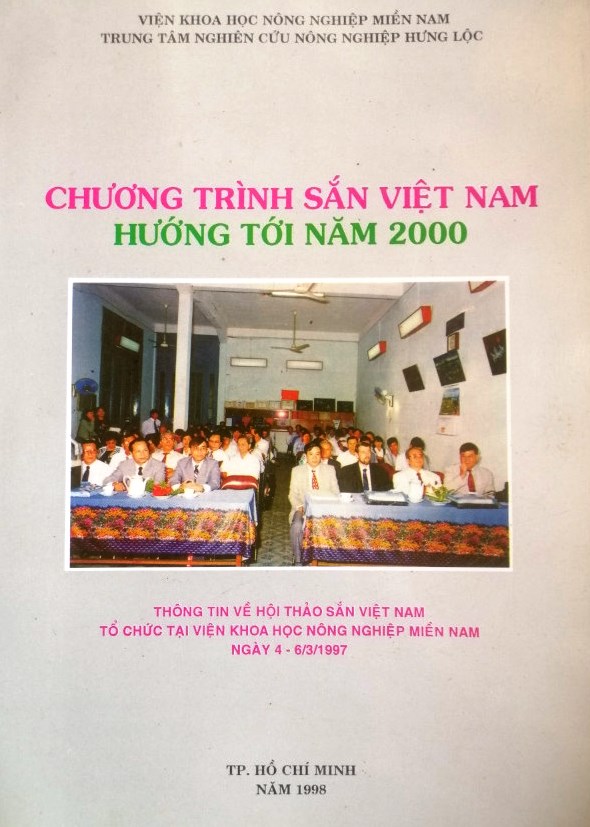
long-time no hear
From: Howeler, Reinhardt (CIAT-Emeritus) r.howeler@cgiar.org
To: Hoàng Kim hoangkimvietnam1953@gmail.com
Hello Dr. Kim:
I hope you saw the letter I wrote to you on June 26 this year, informing you that my wife of 53 years, Jane, had passed away after a long and painful disability due to a disinformation of her spine. She was 81 years old. Let me know if you did not get this letter.
I am not sure whether you are retired yet or not, but I am sure you have remained busy writing and organizing activities about cassava. For the past ten years I have been busy taking care of my wife, day and night, so I did not have time for much else. Now that she is no longer alive, I am home alone, although I have some company from a Mexican man who has rented a room in our house. It also means that I have more time to other things, besides walking, bicycling and swimming every day to stay healthy. I am now 79 years old. Currently, I am organizing a box full of old photos. I came across some photos about an award Dr. Kawano and myself received from the Minister of Agriculture of Vietnam. This was during one of our Workshops in Ho Chi Minh City, but I forgot the exact dates, or even the year. Some of the photos show that the workshop was held from March 4-6, 199….. If you can tell me the year this happened I would much appreciate it, so I can date the photos and put them in a photo book. This was one of the highlights of my long cassava career, which has left me with many good memories.
Looking forward to hear from you. I hope you and your family are doing well and remain healthy.
With best regards. Reinhardt
Xin chào tiến sĩ Kim:
Tôi hy vọng bạn đã nhìn thấy bức thư tôi viết cho bạn vào ngày 26 tháng 6 năm nay, thông báo với bạn rằng người vợ 53 năm chung sống của tôi, Jane, đã qua đời sau một thời gian dài và đau đớn vì khuyết tật cột sống của cô ấy. Bà đã 81 tuổi. Hãy cho tôi biết nếu bạn không nhận được thư này.
Tôi không chắc là bạn đã nghỉ hưu hay chưa, nhưng tôi chắc rằng bạn vẫn bận rộn với việc viết và tổ chức các hoạt động về sắn. Cả chục năm nay tôi bận bịu chăm sóc vợ cả ngày lẫn đêm nên tôi không có thời gian cho việc khác. Bây giờ cô ấy không còn sống nữa, tôi ở nhà một mình, mặc dù tôi có một số công ty từ một người đàn ông Mexico đã thuê một phòng trong nhà của chúng tôi. Điều đó cũng có nghĩa là tôi có nhiều thời gian hơn cho những việc khác, ngoài việc đi bộ, đi xe đạp và bơi lội mỗi ngày để giữ gìn sức khỏe. Bây giờ tôi đã 79 tuổi. Hiện tại, tôi đang tổ chức một hộp đầy những bức ảnh cũ. Tôi đã xem qua một số bức ảnh về giải thưởng mà Tiến sĩ Kawano và bản thân tôi đã nhận được từ Bộ trưởng Bộ Nông nghiệp Việt Nam. Đây là trong một trong những Hội thảo của chúng tôi tại Thành phố Hồ Chí Minh, nhưng tôi đã quên ngày tháng chính xác, hoặc thậm chí cả năm. Một số hình ảnh cho thấy hội thảo được tổ chức từ ngày 4-6 / 3/199… .. Nếu bạn có thể cho tôi biết năm mà điều này xảy ra thì tôi rất cảm kích, vì vậy tôi có thể xác định niên đại của các bức ảnh và đưa vào sách ảnh. Đây là một trong những điểm sáng trong sự nghiệp trồng sắn lâu đời của tôi, nó đã để lại cho tôi rất nhiều kỷ niệm đẹp.
Mong được nghe từ bạn. Tôi hy vọng bạn và gia đình của bạn đang làm việc tốt và vẫn khỏe mạnh. Trân trọng kính chào. Reinhardt
Greetings from HoangKimVietnam
From: Hoàng Kim hoangkimvietnam1953@gmail.com; hoangkim.vietnam@gmail.com
To: Howeler, Reinhardt (CIAT-Emeritus) r.howeler@cgiar.org
Vietnamese cassava today
Miss you Christmas season
Hoang Kim
Good friends are hard to find, hard to leave behind and impossible to forget. The cassava revolution in Vietnam https://youtu.be/81aJ5-cGp28 is a success story. Vietnamese cassava today, https://hoangkimlong.wordpress.com/category/vietnamese-cassava-today/ the urgency to preserve and develop cassava sustainably. Greetings from HoangKim Vietnam VNCP to Howeler, Martin and friends CIAT, ACIAR “Establishing sustainable solutions to cassava diseases in mainland Southeast Asia”. Merry Christmas and Happy New Year.
Dear Dr. Reinhardt Howeler,
Hello teacher and great friend of Asian cassava farmers. Photo 1 The Global Cassava Workshop in Vietnam in 2000, with the beloved wife of Reinhardt Howeler, and Professor Pham Van Bien, Director of the Southern Institute of Agricultural Science and Technology, seated in the front row on the left. Now she is gone. Please give us belated condolences to you. I and VNCP lost your email. The photo is a silent gratitude in our hearts. Photo 2 Dr. Reinhardt Howeler and Dr. Kazuo Kawano receives the State Prize of Vietnam, presented by Mr. Nguyen Gioi, Deputy Minister of MARD, and Professor Pham Van Bien, Director of IAS, on 4/3/1997. Photo 3 is seven books on CIAT Vietnam, late 20th century and early 21st century, recognizing your outstanding contributions. Photo 4 is Luis Eduardo Barona and Hoang Kim with cassava variety C39 at CIAT in 2003 in collaboration with Hernan Ceballos and Martin Fregene. Photo 5 is the main cassava variety KM419 of Vietnam’s cassava today.
You are always in our hearts. We will always remember and thank you.
My warm greetings to you.
Best regards, Hoang Kim
Giáo sư Martin Fregene quý mến
Lời chào từ Hoàng Kim Việt Nam, VNCP phúc đáp thư bạn. Chúc bạn và gia đình vui khỏe, hạnh phúc trong Giáng sinh sắp diễn ra. Hoàng Kim và gia đình khỏe. Mình đã nghỉ hưu, nhưng tôi vẫn đang tiếp tục nghiên cứu về sắn ở VNCP phối hợp với TS Nguyễn Thị Trúc Mai, DARD Phú Yên và TS Hoàng Long, NLU. Chủ đề là “Nghiên cứu tuyển chọn giống sắn năng suất tinh bột cao, kháng được sâu bệnh hại chính (CMD, CWBD) phù hợp với điều kiện sản xuất tại tỉnh Phú Yên và các vùng phụ cận.
Tôi đã thấy trên Twitter tại đường dẫn đến dòng tweet https://twitter.com/cassdiseaseasia/status/1460897971063570433?s=21 về hai giống sắn CR24-16 và TMEB419 và video của DNRTV http://dnrtv.org.vn/tin-tuc-n107515/benh-kham-la-mi.html , nói về giống sắn TMEB419, và video của TNRTV https://youtu.be/QCo_eFohvpQ
Chúng tôi chưa tham gia vào việc phát triển hai giống sắn này, vì chưa có hai giống sắn ấy, và chưa biết rõ tài liệu tự công bố ở Việt Nam về năng suất củ tươi, hàm lượng tinh bột và năng suất tinh bột ổn định của giống sắn TMEB419 ở Việt Nam trong sự so sánh với số liệu gốc của IITA goseed cassava, https://iitagoseed.com/goseed-cassava/ , là tài liệu tự công bố ở châu Phi. Hoàng Kim xin trả lời Martin Fregene về câu hỏi “Làm thế nào để họ chấp nhận được đối với nông dân ở Việt Nam”?: Bạn cần phải có số liệu công bố kết quả thực nghiệm DUS và VCU tại Việt Nam, được MARD chấp nhận, về hai giống sắn CR24-16 và TMEB419, theo quy chuẩn quốc gia Việt Nam.
Sắn Việt Nam ngày nay, đều có gen kháng CMD của giống sắn C39 từ CIAT, cũng là gia đình của CR24-16 với các giống sắn KM419, KM440, KM568, KM535, KM534, KM536, KM537, KM440, KM397. Như bạn đã biết, tôi tới CIAT năm 2003 để làm việc với Hernan Ceballos và Martin về chọn giống sắn DH. Việt Nam năm 2003 đã nhập nội giống sắn từ CIAT, có giống C39, và có đủ hồ sơ nhập giống sắn của CIAT với giấy phép của MARD. Vì vậy, tôi biết rất rõ hiệu suất của dòng C39 mà tôi đang hiện có ngày nay, tuyển chọn từ năm 2003 (*). Tôi và “nhóm Hoàng Kim” từ đó đến nay đã liên tục làm việc Bảo tồn và phát triển sắn, gồm: Giống sắn chủ lực KM419, cũng là tác giả của các giống sắn phổ biến trước đó tại Việt Nam KM140, KM98-5, KM98-1, KM94 (tên gốc KU50), SM937-26. Ở Việt Nam, giống sắn KM419 và KM440 đến nay là phổ biến nhất, sau cả áp lực nặng của bệnh khảm lá CMD và bệnh chổi rồng CWBD. https://youtu.be/XDM6i8vLHcI và https://youtu.be/kjWwyW0hkbU chúng tôi khuyên nông dân nên trồng các loại giống sạch bệnh KM568, KM535, KM419, KM440, KM94, KM140, KM98-1, HN5, HLS14 (và hai giống sắn CR24-16 và TMEB419 nếu có) để khảo nghiệm DUS và VCU. Sắn Việt Nam bảo tồn và phát triển bền vững: xem thêm https://hoangkimlong.wordpress.com/category/chon-giong-san-khang-cmd/
Cảm ơn bạn vì sự liên kết thông tin quan trọng này. Lời chào nồng nhiệt của tôi đến gia đình bạn. Trân trọng Hoàng Kim
(*) Hoang Kim, Nguyen Phuong, Hoang Long, Tran Cong Khanh, Hernan Ceballos, Rod Lefroy, Keith Fahrney, Tin Maung Aye and Reinhardt Howeler 2010. Recent progress in cassava breeding and the selection of improved cultivars CIAT. In: A New Furture for Cassava in Asia: Its Use as Food, Feed and Fuel to Benefit the Poor. 8th Asian Cassava Research Workshop October 20 – 24, 2008 in Vientiane, Lao PDR. papers 223 – 233
Greetings from Martin Fregene
From: Martin Fregene <mfregene@gmail.com>
To: Hoàng Kim hoangkimvietnam1953@gmail.com
Dear Hoang Kim
This is Martin Fregene saying hello after a long time! How are you and your family? Are you still in cassava research or you have retired and moved to a private sector company? I saw on Twitter this tweet about two varieties recently released in Vietnam CR24-16 and TMEB419, see the link to the tweet below. Were you involved in the development of these varieties? Do you know the fresh root yield, starch yield and starch yield stability of the two varieties? How acceptable are they to farmers?
https://twitter.com/cassdiseaseasia/status/1460897971063570433?s=21
As you know I left CIAT to the US and now working at the African Development Bank in Abidjan. But I was involved in the production of C18, one of the parents of CR24-16, and even the progeny while at CIAT as part of the CMD molecular breeding program. So I am interested in the performance of the CR24-16 line. Thanks for any information you can provide and I look forward to hearing from you soon.
My warm regards to your family.
Sincerely
Martin
Greetings from HoangKimVietnam
From: Hoàng Kim hoangkimvietnam1953@gmail.com; hoangkim.vietnam@gmail.com
To: Martin Fregene <mfregene@gmail.com>
Dear Professor Martin Fregene
Greetings from Hoang Kim Vietnam, VNCP replies to your letter. Wishing you and your family a happy and healthy Christmas in the coming time. Hoang Kim and family are healthy. I am retired, but I am still continuing to research cassava at VNCP in collaboration with Dr. Nguyen Thi Truc Mai, DARD Phu Yen and Dr. Hoang Long, NLU. The topic is “Study on selection of cassava varieties with high starch yield, resistant to major pests and diseases (CMD, CWBD) suitable for production conditions in Phu Yen province and surrounding areas”. I saw it on Twitter. at the link to the tweet https://twitter.com/cassdiseaseasia/status/1460897971063570433?s=21 about the two cassava varieties CR24-16 and TMEB419 and DNRTV’s video http://dnrtv.org.vn/tin-tuc- n107515/benh-kham-la-mi.html , talk about cassava variety TMEB419, and video by TNRTV https://youtu.be/QCo_eFohvpQ
We have not participated in the development of these two cassava varieties, because there are not two varieties of cassava yet, and we do not know the self-published documents in Vietnam on fresh tuber yield, starch content and stable starch yield. Determination of cassava variety TMEB419 in Vietnam in comparison with original data from IITA goseed cassava, https://iitagoseed.com/goseed-cassava/, which is self-published in Africa. Hoang Kim would like to answer Martin Fregene on the question “How can they be acceptable to farmers in Vietnam”?: You need to have data published on experimental results of DUS and VCU in Vietnam, approved by MARD accepted, about two varieties of cassava CR24-16 and TMEB419, according to the national standards of Vietnam. In Vietnam, cassava varieties KM419 and KM440 are by far the most popular, after both the severe pressure of CMD and CWBD. https://youtu.be/XDM6i8vLHcI and https://youtu.be/kjWwyW0hkbU we advise farmers to plant disease-free varieties KM568, KM535, KM419, KM440, KM94, KM140, KM98-1, HN5, HLS14 (and two cassava varieties CR24-16 and TMEB419 if available) for DUS and VCU testing. Vietnamese cassava conservation and sustainable development: see more https://hoangkimlong.wordpress.com/category/chon-giong-san-khang-cmd/
Today’s Vietnamese cassava all have CMD resistance gene of C39 cassava variety from CIAT, also family of CR24-16, with cassava varieties KM419, KM440, KM568, KM535, KM534, KM536, KM537, KM440, KM397. As you know, I went to CIAT in 2003 to work with Hernan Ceballos and Martin on DH cassava breeding. Vietnam in 2003 imported cassava varieties from CIAT, has C39 variety, and has enough records to import cassava varieties from CIAT with MARD’s license. So I know very well the performance of the C39 series I have today, sifting from 2003 (*). Since then, “Hoang Kim team” and I have been continuously working on the conservation and development of cassava, including: The main cassava variety KM419, also the author of the previously popular cassava varieties in Vietnam KM140, KM98- 5, KM98-1, KM94 (original name KU50), SM937-26. Thank you for this important informative link.
My warm greetings to your family.
Best regards, Hoang Kim

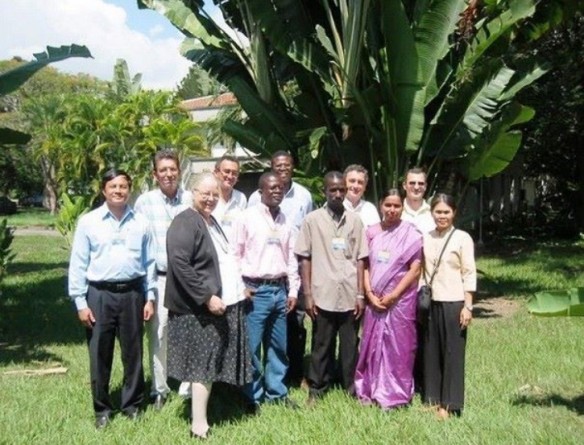
VIETNAMESE CASSAVA TODAY
Sắn Việt Nam với Hernan Cebanlos
Hoàng Kim
Greeting from Hoang Kim Vietnam to Hernán Ceballos Lascano and my teachers and friends. Best wish to you and your family on New Days; Good friends are hard to find, harder to leave, and impossible to forget see more https://hoangkimlong.wordpress.com/category/vietnamese-cassava-today/ and https://hoangkimlong.wordpress.com/category/cach-mang-san-viet-nam/ and https://hoangkimlong.wordpress.com/category/chon-giong-san-khang-cmd/

SẮN VIỆT NAM BẢO TỒN VÀ PHÁT TRIỂN BỀN VỮNG
Hoàng Kim và thầy bạn
Cassava in Vietnam: conservation and sustainable development. Greeting from Hoang Kim Vietnam to Reinhardt Howeler and my teachers and friends. Best wish to you and your family on New Days; Good friends are hard to find, harder to leave, and impossible to forget see more https://hoangkimlong.wordpress.com/category/san-viet-nam-va-howeler/ and https://hoangkimlong.wordpress.com/category/cach-mang-san-0-viet-nam/ and https://hoangkimlong.wordpress.com/category/chon-giong-san-khang-cmd/ — with Nguyen Thi Truc Mai, Hoang Long, Nguyen Bach Mai, Reinhardt Howeler, Mai Van Quyen, Trần Ngọc Ngoạn, Nguyen Minh Hieu, Nguyen Van Bo and Jonathan Newby..
SẮN VIỆT NAM VÀ HOWELER
Hoàng Kim
Sắn Việt Nam và Reinhardt Howeler là bài học lớn. Nhà khoa học danh tiếng này là người bạn lớn của nông dân trồng sắn Thế giới, châu Á và Việt Nam. Ông đã dành trọn đời mình cho cây sắn, đúc kết trên 15 sách sắn chuyên khảo. Bạn tốt khó tìm, khó bỏ lại, và không thể quên lãng (Good friends are hard to find, harder to leave, and impossible to forget) see more xem tiếp. https://hoangkimlong.wordpress.com/category/san-viet-nam-va-howeler/ — với Reinhardt Howeler.
Sách sắn “Quản lý bền vững sắn châu Á từ nghiên cứu đến thực hành” (Nguyên tác tiếng Anh: Sustainable management of cassava in Asia – From research to practice; tác giả tiến sĩ Reinhardt Howeler và tiến sĩ Tin Maung Aye, CIAT, 2015, 148 trang, CIAT Publication No. 396, chỉ số xuất bản ISBN 978-958-694-136-5), Người chuyển ngữ tiếng Việt Hoàng Kim, Hoang Long, Nguyễn Thị Trúc Mai, Nguyễn Bạch Mai; CIAT, VAAS, The Nippon Foundation, Nhà xuất bản thông tấn, 2015. Chỉ số xuất bản 9786049450471. PGS TS Trịnh Khắc Quang, Giám đốc VAAS và Tiến sĩ Clair Hershey, Trưởng Chương trình sắn CIAT đã viết lời giới thiệu và lời nói đầu sách này: (trích) ”Công việc tóm tắt trong tài liệu này thay cho những lời khuyên tốt nhất hiện có sau hơn 50 năm kinh nghiệm thực tiễn kết hợp nghiên cứu và làm việc với nông dân để hiểu những thách thức thực tế cuộc sống và cơ hội mà họ phải đối mặt.”.
Sách này có 13 chương. Chúng tôi trích giới thiệu chương 10 và chương 11 trong bài Sắn Việt Nam và Howeler, được sự đồng ý của tiến sĩ Reinhardt Howeler và tiến sĩ Tin Maung Aye, Nội dung Chương 10:”Kết hợp phân bón thương mại, phân chuồng, phân xanh để cải thiện độ phì nhiêu và tăng năng suất sắn” (trang 89-98).Nội dung Chương 11 Cách thức sinh học để tăng năng suất và cải thiện đất (trang 99 -110).
Chọn giống sắn kháng CMD; Chọn giống sắn Việt Nam; Mười kỹ thuật thâm canh sắn; Cách mạng sắn Việt Nam; Sắn Việt Nam và Kawano, Cassava and Vietnam: Now and Then; Sắn Việt Nam và Howeler; Quản lý bền vững sắn châu Á; Sắn Việt Nam sách chọn; CIAT Colombia thật ấn tượng; Sắn Việt Nam bài học quý, Sắn Việt và Sắn Thái; Lúa sắn Cămpuchia và Lào; Lúa sắn Việt Châu Phi; Martin Fregene xa mà gần; Người lính cây sắn tuổi thơ , Sắn Việt Lúa Siêu Xanh

QUẢN LÝ BỀN VỮNG SẮN CHÂU Á
Từ Nghiên cứu đến Thực hành
Tác giả: Reinhardt Howeler và Tin Maung Aye
Người dịch: Hoàng Kim, Hoàng Long, Nguyễn Thị Trúc Mai, Nguyễn Bạch Mai
LỜI GIỚI THIỆU
Sắn Việt Nam trong vùng sắn châu Á đã tạo được sự đột phá có ý nghĩa toàn cầu. Sắn Việt Nam hiện được FAO (2013) ca ngợi là điển hình của sắn thế giới khi so sánh năm 2000 năng suất sắn Việt Nam đạt 8,35 tấn/ha, gần tương đương với năng suất sắn châu Phi (8,65 tấn/ha) nhưng đến năm 2011 sắn Việt Nam đã đạt năng suất 17,73 tấn/ha, vượt xa năng suất sắn bình quân châu Phi đạt 10,77 tấn/ha và cao hơn hẳn năng suất sắn bình quân châu Mỹ là 12,92 tấn/ha. Tại Tây Ninh, nhiều hộ nông dân đã tăng năng suất sắn lên 400%, từ 8,35 tấn/ ha lên trên 36,0 tấn / ha. Sắn lát và tinh bột sắn Việt Nam đã trở thành một trong mười mặt hàng xuất khẩu chính. Sắn Việt Nam hiện đã thành nguồn sinh kế, cơ hội xóa đói giảm nghèo và làm giàu của nhiều hộ nông dân và hấp dẫn sự đầu tư của nhiều doanh nghiệp chế biến kinh doanh. Dẫu vậy, sắn Việt Nam cũng bộc lộ nhiều rủi ro, bất cập trong sản xuất, chế biến, kinh doanh và bảo vệ môi trường.
Thay mặt cho Viện Khoa học Nông nghiệp Việt Nam, tôi vinh dự được viết lời giới thiệu cho cuốn sách “Quản lý bền vững sắn châu Á: Từ nghiên cứu đến thực hành” của tác giả Reinhardt Howeler và Tin Maung Aye, chủ biên dịch Hoàng Kim với sự cộng tác của Hoàng Long, Nguyễn Thị Trúc Mai, Nguyễn Bạch Mai. Cuốn sách này đúng như lời tác giả “thay cho những lời khuyên tốt nhất hiện có về kỹ thuật canh tác sắn sau hơn 50 năm kinh nghiệm thực tiễn kết hợp nghiên cứu và làm việc với nông dân để thấu hiểu những thách thức thực tế cuộc sống và cơ hội mà họ phải đối mặt”. Mặt khác, cuốn sách cũng là cẩm nang nghề nghiệp cho những người làm công tác nghiên cứu, chỉ đạo sản xuất và hoạch định chính sách về cây sắn, là cầu nối để trao đổi, thảo luận về các vấn đề cùng quan tâm trong quản lý đất và canh tác sắn bền vững ở châu Á.
Kính chúc bà con nông dân những mùa thu hoạch sắn bội thu.
Trịnh Khắc Quang
Giám đốc Viện Khoa học Nông nghiệp Việt Nam (VAAS)
LỜI NÓI ĐẦU
Sắn là một trong những loại cây trồng thích nghi vùng cao phổ biến nhất ở châu Á vì tính linh hoạt của nó trong hệ thống cây trồng, khả năng sản xuất thuận lợi trong điều kiện khó khăn và tính đa dụng cung cấp thực phẩm, thức ăn gia súc, nguồn thu nhập cho hộ nông dân. Mặc dù sắn có tiếng là cây dễ trồng, nó vẫn đòi hỏi phải quản lý tốt để có được năng suất cao qua các năm, đi đôi việc bảo vệ nguồn đất và nước.Thế giới nông nghiệp đang chuyển đổi một cách nhanh chóng và cây sắn cũng không tránh khỏi sự thay đổi này. Một mặt, thị trường sắn và sản phẩm sắn đang tăng trưởng ở một số nước châu Á với khả năng thu lợi nhiều hơn từ cây này. Nhiều giống sắn mới năng suất cao là có giá trị đối với hệ thống sản xuất và sự hiểu biết về quản lý đất và cây trồng tối ưu đã được tăng đều đặn. Đồng thời, vấn đề sâu bệnh cũng trở nên quan trọng và thường ảnh hưởng đến sản lượng cây trồng. Kiểm soát chúng đòi hỏi kiến thức tốt và quản lý cẩn thận. Có nhiều lựa chọn trong hoạt động quản lý cây trồng như chuẩn bị đất, mật độ trồng, quản lý cỏ dại và các công cụ thu hoạch. Việc sản xuất cây giống chất lượng cao (hom và hạt giống) có lợi thế tiềm năng mà thường không được đánh giá đầy đủ bởi người trồng sắn. Quản lý độ phì đất là thực hành cốt lõi mang lại thành công lâu dài cho nhiều nông dân trồng sắn. Hiểu biết thấu đáo các yếu tố đầu vào và thực hiện những điều đó góp phần tối ưu hóa năng suất, về lâu dài là nền tảng thành công của một người nông dân trồng sắn.
Nhưng kết hợp đúng thực tiễn cần được cụ thể cho mỗi trang trại. Những người nông dân trồng sắn thường không dễ tiếp cận thông tin chuẩn mực về thực hành quản lý tốt nhất. Ở hầu hết các nước, hệ thống khuyến nông cung cấp tư vấn kỹ thuật cho người nông dân trồng sắn không phát triển như đối với cây lúa hoặc cây ngô và thỉnh thoảng còn không có. Các chuyên gia tư vấn thường là cán bộ khuyến nông, các đại diện bán hàng của công ty cung cấp nguyên liệu đầu vào như phân bón hay thuốc trừ sâu, hay các chuyên viên kỹ thuật của các công ty chế biến. Họ thường làm việc với nhiều loại cây trồng và nhiều nông dân, hoặc có thể có các lợi ích thương mại với động cơ mua bán sản phẩm hoặc dịch vụ cụ thể. Hầu hết các công nghệ được phát triển cho sắn được thiết kế thân thiện môi trường, nghĩa là không phụ thuộc vào đầu vào cao của hóa chất hoặc các thực hành bất lợi. Điều quan trọng là công nghệ được phổ biến và phát huy tận dụng mối quan tâm đối với môi trường.
Cuốn sách này nhằm mục đích cung cấp thông tin có cơ sở tốt về quản lý cây sắn để nông hộ thu lợi tối đa và phát triển tốt hơn trong khi vẫn bảo tồn độ phì nhiêu của đất và phát triển bền vững lâu dài. Nó được dựa trên những kinh nghiệm và kết quả nghiên cứu từ nhiều thập kỷ qua, đặc biệt không chỉ ở châu Á mà còn ở châu Phi và châu Mỹ Latinh. Rất nhiều thông tin được phát triển bởi sự tham gia làm việc giữa Trung tâm Quốc tế Nông nghiệp Nhiệt đới (CIAT) – có trụ sở ở Cali, Colombia, và một văn phòng khu vực châu Á, trước đây đặt ở Bangkok, Thái Lan và hiện nay đang đặt ở Hà Nội, Việt Nam – với các tổ chức đối tác trong khu vực. Các đối tác này được đề cập trong tài liệu thông qua hướng dẫn thảo luận các thí nghiệm hoặc công nghệ liên quan. Nhiều nông dân tham gia phát triển ý tưởng và giải pháp trong chương trình nghiên cứu có sự tham gia của nông dân (FPR). Đây là một phần quan trọng trong việc đảm bảo sự phù hợp thực tế của các kết quả.
Cuốn sách được thiết kế cho những người cung cấp tư vấn trực tiếp đến nông dân, cũng như các giáo viên, nhà nông học, sinh viên, cán bộ khuyến nông, đại lý nông sản và công nghiệp chế biến cùng những ai quan tâm đến quản lý đất và cây trồng bền vững đối với sắn ở châu Á. Sách cũng được dùng để cung cấp thông tin tư vấn trực tiếp đến nông dân, những người hiểu biết kỹ thuật canh tác sắn để vận dụng phù hợp với điều kiện cụ thể của mình. Tuy sách chưa có hướng dẩn chi tiết tại trang trại cá nhân nhưng nó là cẩm nang hướng dẫn cho cán bộ khuyến nông và những người làm việc với cộng đồng nông dân để điều chỉnh thích hợp với nhu cầu cụ thể. Chúng tôi mời các đối tác quốc gia sử dụng hướng dẫn này một cách tự do để phát triển các tài liệu bổ sung cho mục đích đào tạo và khuyến nông địa phương.
Các tác giả cuốn sách này là tiến sĩ Reinhardt Howeler và Tin Maung Aye đã làm việc rộng khắp với một loạt các đối tác, các trạm thí nghiệm và trên đồng ruộng của nông dân. Công việc tóm tắt trong tài liệu này thay cho những lời khuyên tốt nhất hiện có sau hơn 50 năm kinh nghiệm thực tiễn kết hợp nghiên cứu và làm việc với nông dân để hiểu những thách thức thực tế cuộc sống và cơ hội mà họ phải đối mặt.
Sách hướng dẫn này sẽ không thể thực hiện được nếu không có sự hỗ trợ của quỹ Nippon. Những gắn bó hơn hai thập kỷ hỗ trợ kinh phí cho các hoạt động nghiên cứu, đào tạo và phát triển mạng lưới trên khắp Đông Nam Á. CIAT trân trọng cảm ơn vai trò quan trọng của Quỹ Nippon trong các sáng kiến nghiên cứu phát triển thông tin bao gồm hướng dẫn này, cũng như hỗ trợ biên dịch và sản xuất tài liệu hướng dẫn.
Chương trình sắn CIAT hân hạnh giới thiệu hướng dẫn này để sử dụng trong việc quản lý hệ thống sản xuất trồng sắn nhằm tối ưu hóa lợi ích ngắn và dài hạn cho nông dân cũng như để bảo vệ môi trường.
Clair Hershey
Trưởng Chương trình sắn CIAT
Giới thiệu về tác giả

Reinhardt Howeler sinh tại Indonesia nhưng lớn lên ở Hà Lan. Sau khi tốt nghiệp ở Học viện Nông nghiệp Nhiệt đới, ông di cư sang Mỹ tiếp tục nghiên cứu của mình và lấy bằng tiến sĩ về hóa học đất tại Trường Đại học Cornell. Ông tham gia tổ chức CIAT ở Cali, Colombia năm 1970, khi chương trình sắn mới được thành lập năm 1972. Ông tiến hành các thí nghiệm trong nhà kính để xác định nhu cầu dinh dưỡng của cây sắn và làm thế nào để quản lý sắn không bị xói mòn nghiêm trọng. Năm 1986, ông chuyển đến văn phòng CIAT châu Á tại Bangkok, Thái Lan và ở lại đây suốt thời gian 23 năm. Ông đã làm việc chặt chẽ với các nhà nghiên cứu, cán bộ khuyến nông và nông dân trong điều kiện thực tế với tất cả các nước trồng sắn trong khu vực, phát triển các hoạt động quản lý đất và cây trồng tốt hơn, và tăng cường ứng dụng chúng bằng cách sử dụng phương pháp nghiên cứu có sự tham gia của nông dân (FPR). Kết quả là sản lượng sắn ở châu Á tăng lên đáng kể, cho phép sự gia tăng nhanh chóng của công nghiệp chế biến và sử dụng sắn, tăng cung cầu sử dụng sắn, cải thiện thu nhập và đời sống của nhiều nông hộ trồng sắn. Reinhardt Howeler là chuyên gia sắn nổi tiếng, biên soạn nhiều sách và đã được vinh danh tại Việt Nam (ND).

Tin Maung Aye đã được sinh ra và lớn lên ở Myanmar, ở đó ông nhận bằng Cử nhân Nông nghiệp của Viện Nông nghiệp Yezin năm 1984. Sau khi làm việc như một trợ lý nghiên cứu trong ba năm ông chuyển đến Thái Lan, nơi ông hoàn thành bằng Thạc sĩ trong hệ thống nông nghiệp ở Viện Công nghệ Châu Á (AIT) tại Bangkok vào năm 1994. Sau khi làm việc ở các vị trí khác nhau tại AIT, ông tham gia nghiên cứu của tổ chức Landcare Ltd. tại New Zealand với tư cách là một nhà phân tích hóa học, và sau đó làm việc như một trợ lý nghiên cứu tại Trung tâm Nghiên cứu Phân bón và Vôi tại Đại học Massey. Ông đã hoàn thành bằng tiến sĩ về khoa học đất từ Đại học Massey ở New Zealand vào năm 2001. Ông đã làm việc cho chương trình sắn CIAT như một nhà khoa học đất và nông học sắn từ năm 2005, bốn năm đầu tiên ở Lào và sau đó chủ yếu tại Campuchia, Lào, Việt Nam và Myanmar. Ông hiện đang làm việc tại Văn phòng khu vực châu Á-CIAT tại Hà Nội. Trong suốt sự nghiệp của mình, ông đã hoạt động trong nông nghiệp cộng đồng và các tổ chức chuyên nghiệp với mục tiêu hỗ trợ xóa đói giảm nghèo và nâng cao tính bền vững nông nghiệp ở vùng cao ít được ưa chuộng của vùng nhiệt đới châu Á và Thái Bình Dương, đặc biệt ở Đông Nam Á.

CÁCH MẠNG SẮN VIỆT NAM
Hoàng Kim
Cách mạng sắn Việt Nam https://youtu.be/81aJ5-cGp28 Chọn giống sắn Việt Nam thành tựu và bài học là kinh nghiệm quý giá cho công việc Chọn giống sắn kháng CMD cấp bách hiện nay. Giống sắn KM419 và KM94 với 42% và 37% diện tích sắn Việt Nam với khoảng 50% và 40% diện tích sắn Campuchia, đang được sử dụng để tích hợp các gen kháng vi-rút khảm lá sắn CMD. Giống sắn KM98-1 ( là giống sắn Việt MARD certificate No. 3493/QD-BNN–KHKT, Sep 9, 1999, có cùng nguồn gốc cha mẹ với giống sắn Rayong 72 của Thái Lan),hiện đang được xác định là giống sắn chủ lực ở Lào ngày nay. Ở Việt Nam, sắn là cây lương thực quan trọng thứ ba sau lúa và ngô. Sắn Việt Nam ngày nay là một ngành xuất khẩu đầy triển vọng với diện tích hơn nửa triệu ha và giá trị xuất khẩu hơn một tỷ đô la Mỹ mỗi năm. Cách mạng sắn Việt Nam, với sự tham gia của hàng triệu nông dân trồng sắn Việt Nam, đã thực sự đạt được sự chuyển đổi to lớn cây sắn và ngành sắn về năng suất, sản lượng, giá trị sử dụng, hiệu quả kinh tế, thu nhập thực tế, sinh kế, việc làm và bội thu giá trị lao động sống ngành sắn cho hàng triệu người dân trên toàn quốc.Sắn Việt Nam hôm qua và ngày nay đã và đang tiếp tục làm cuộc cách mạng xanh mới.

CASSAVA AND VIETNAM: NOW AND THEN
Kazuo Kawano
CNM365 Tình yêu cuộc sống Cây Lương thực Việt Nam Cách mạng sắn Việt Nam xin trân trọng giới thiệu phóng sự ảnh: Cassava and Vietnam: Now and Then (Sắn và Việt Nam: bây giờ và sau đó) của giáo sư tiến sĩ Kazuo Kawano, người Nhật, chuyên gia chọn giống sắn hàng đầu Thế giới. Cách mạng sắn Việt Nam là chuyện nhiều năm còn kể. Bạn tốt khó tìm, khó bỏ lại, và không thể quên lãng (Good friends are hard to find, harder to leave, and impossible to forget). https://hoangkimlong.wordpress.com/category/cach-mang-san-viet-nam/

Cassava and Vietnam: Now and Then
(キャッサバとベトナム-今昔物語)
Kazuo Kawano
I visited Vietnam for a week this last December, where a team of NHK video-taped for a documentary of the changes caused by the new cassava varieties I introduced 20 years ago in the lives of small framers, the enhanced activities of industrial and business communities and the development of research organizations. It was a most interesting, amusing and rewarding visit where I reunited with a multitude of former small farmers who are more than willing to show me how their living had been improved because of KM-60 and KM-94 (both CIAT-induced varieties) , many “entrepreneurs” who started from a village starch factory, and several former colleagues who became Professor, Vice Rector of Universities, Directors of research centers and so on. Vietnam can be regarded as a country who accomplished the most visible and visual progress most rapidly and efficiently utilizing CIAT-induced technology.
For my own record as well as for responding to the requests from my Vietnamese colleagues, I decided to record the changes and progress that had taken place in Vietnam in general and in cassava varietal development in particular in a series of picture stories. This is the first of long stories that would follow.
昨年の12月に、NHKの国際ドキュメンタリー番組の収録でベトナムを10年ぶりに再訪する機会があった。それは私が中心となって開発したキャッサバの多収性・高澱粉性の新品種群を20年 前に導入した事が引き起こした人々の生活向上の様子を、南から北へと訪ね歩く旅であった。今回の旅では、小農から出発して家を建て中農、富農となった多数 の人々、村の澱粉加工所の親父だったのが大工場のオーナーや実業家となっている幾人もの成功者、そして殆んど名前だけの研究員であったのが今や試験場長、 大学教授、副学長になっている昔の仲間達を訪ね歩いたが、その殆んどの人が私との再会を喜んでくれて、口々に新しいキャッサバ品種のおかげで自分達の生活 と境遇が革命的に良くなったと話してくれた。
私自身の記録のため、それにベトナムの昔の仲間からのリクエストに答える目的もあって、この20年間のベトナムの発展とキャッサバ生産の進展を絵物語風に書き留めることにした。これはその長い物語の始まりの章である。

The basis of Vietnamese agriculture is rice. Cassava is planted on the upper parts.

In flat, dry area, they plant cassava predominantly

Meeting old friends at Hung Loc Agricultural Research Center:Now, Hoang Kim is Senior Lecturer at Nong Lam University in Ho Chi Minh city and Nguyen Huu Hy is Director of Hung Loc Agricultural Research Center

Reunion with advanced farmer Mr. Ho Sau with Hoang Kim and students in Trang Bom, Dong Nai

Reunion with advanced farmer Mr. Tong Quoc Thanh with Hoang Kim in Tay Ninh

Meeting Former Director Truong Van Ho, old colleague Trinh Thi Phuong Loan (Retired as Deputy Director) and other friends at Root Crop Research Center, Vietnam Agricultural Science Institute in Hanoi

Meeting Tran Ngoc Ngoan (Now, Vice-Rector of Thai Nguyen University), Mrs. Loan and Mr. Ngo Trung Kien (an advanced farmer) in Mr. Kien’s house, Pho Yen, Bac Thai
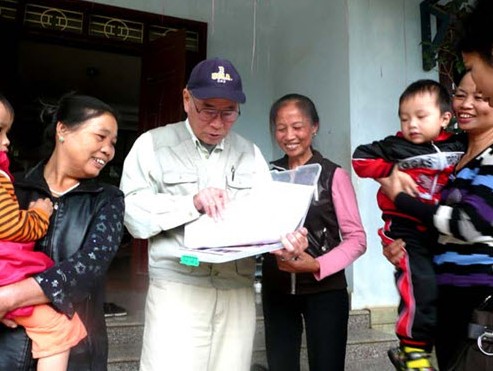
Meeting Mrs. Sau and Mrs. Quyen, successful former cassava farmers, in Hatay, near Hanoi

Giving concluding remarks in the end of Vietnam Journey in Lake Hoan Kiem, Hanoi,
5 Dec 2009
A BRIEF HISTORY OF A SUCCESSFUL BREEDING PROGRAM
As is widely known, Vietnam has accomplished a rapid economic development in recent 20 years. During the same period, , cassava, starting from a low status crop grown by small farmers and consumed as human food by poor people, has grown into a major crop providing raw materials for animal feeding, industrial starch processing and most recently bio-ethanol production (though I have some reservations for using cassava for this purpose), thus bringing precious cash income to millions of small farm families. When I first visited Vietnam in 1988, cassava’s acreage all over the country was 0.28 million ha with mean yield of 8.4 t/ha. It now occupies 0.56 million ha (official figure: the actual figure is said to be around 0.65 million ha; the emphasis of research is gradually shifting from varietal improvement to soil conservation) with 15.9t/ha mean yield. Vietnam has now advanced to World No. 2 exporter of cassava products next only to Thailand.
It is extremely gratifying to witness this progress toward the end of my career; then, what made this experience possible? The breeding work that has brought this result started when I joined CIAT as cassava breeder in 1973, where CIAT was inaugurating an integrated cassava research program with global mandate by recruiting a half dozen of young PhD from world reputable universities. As such, I initiated a comprehensive cassava breeding program using a population which contained a vast genetic variation coming from more than 2000 native varieties collected from the centers of origin and diversification of cassava all over Latin America.
Especially noteworthy in this process is the fact that those countries such as Colombia, Brazil and Mexico where abundant cassava germplasm existed donated to or allowed CIAT to collect native cassava varieties on the condition that the newly established international research center CIAT uses all these germplasm for the welfare of people in the world without pursuing any monetary profit. It goes without saying that those rural small farmers who grew native cassava varieties inherited from their ancestors were very cooperative with the CIAT collection. The researchers as well the early CIAT administration clearly shared the immeasurable importance of basic germplasm in pursuing large scale breeding.
I accomplished much of the basic breeding during the first 10 years at CIAT/Colombia and moved to Thailand in 1983 by opening a CIAT/Asia office on the understanding that the effect of cassava varietal improvement would be more eminent in Asia. Thus, I started a more practical breeding in close collaboration with Thai workers. Here again, we were very thankful that the Colombian government allowed us to transfer cassava breeding materials to Asia without condition. As a result, I had transferred more than 1 million genotypes of cassava, mainly in the form of F1 hybrid seeds, from Latin America to Asia during the 15 years that followed.
This breeding work, based on the hybridizations between Latin American and Thai materials, resulted in a great success and produced many superior varieties. Now, some 97% of the total 1.15million ha of cassava in Thailand is planted with these new varieties we developed. I transferred many advanced breeding materials from Thailand to other Asian countries such as Indonesia, Philippines, China and Vietnam. In this process as well, the Thai government authorization of transferring our breeding materials to other Asian countries, which could well be potential (in fact, actual) competitors to Thailand, was to be highly appreciated.
In 1989, I brought planting stakes of Rayong 60 and Kasetsart 50 among others as a check-in baggage of the Bangkok-Ho Chi Minh flight (The import and plant quarantine permit had been very willingly arranged by the Vietnamese institution). Upon harvesting the first cycle evaluation /multiplication at Hung Loc Center in 1990, I carried the planting stakes of these varieties from HCM to Hanoi to be evaluated and multiplied by the research institutions in the North. In retrospect, my action was rather unorthodox power play. Nevertheless, considering that this was the beginning of a long story which would develop to generating an annual additional economic effect in the order of 200 million US dollars to be shared by the millions of small farmers, power play may be justified on certain critical occasions.

F1 selection at CIAT/Colombia in1976
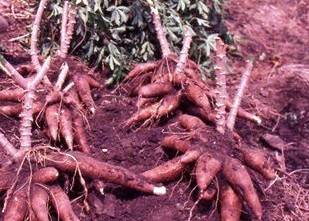
One of the early selections, CIAT/Colombia circa 1980

F1 selection at Rayong Center, Thailand, circa 1987

Rayong 60 in Feb 1988 at Rayong Center, one of the major early successes at CIAT/Thai collaborative breeding program
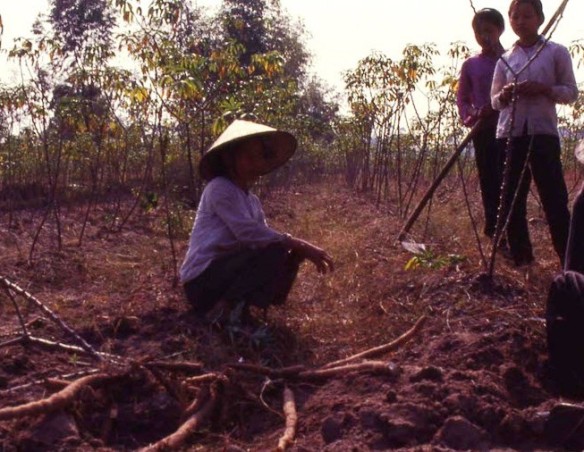
A typical cassava field in North Vietnam in 1989
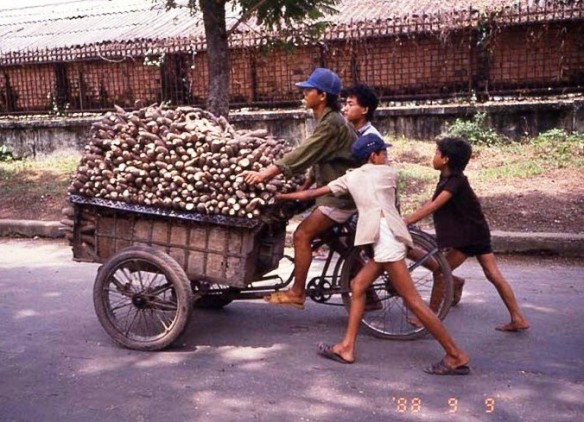
Cassava harvest being carried to market in Ho Chi Minh city in 1988

Processing cassava for noodle near Bien Hoa in 1988
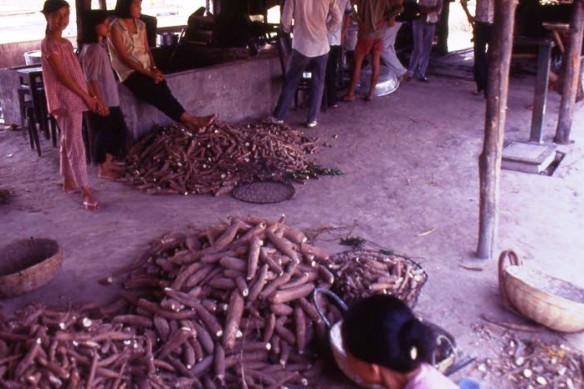
Cassava starch processing as a cottage industry in Tay Ninh early 1990s
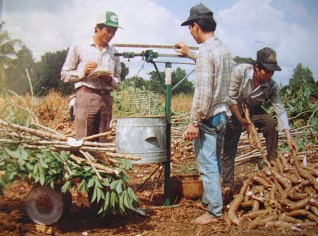
By 1996, farmers can harvest more cassava for feeding pigs by planting new varieties (Here is KM-60 or Rayong 60 in Hung Loc Agricultural Research Center, Dong Nai Province (1990) and Ha Tay Province (1996)

Large scale cassava starch factories began to appear in Tay Ninh circa 1996
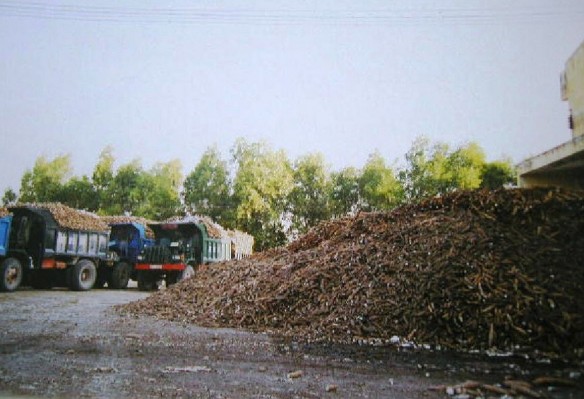
Cassava starch production became a big business following the step of Thailand (Tay Ninh 2009)
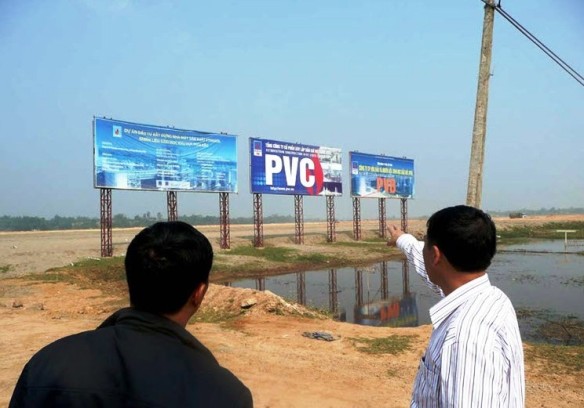
Now, the Bio-ethanol processing using cassava (A new Bio-Ethanol Plant is being built in Phu Tho)
Ho Chi Minh city (Saigon)
I began my first trip report to Vietnam 22 years ago with the following phrase “As the Air France flight 174 landed eventlessly at the airport of Ho Chi Minh City, only the vastness of the airport reminded me of its once familiar name of Tan Son Nhut, which was now more a symbol; of disrepair and abandonment.” Now, two decades later, Ho Chi Minh city is an entirely different place. See the town before and now.

The tallest building I could see in 1988. It had an eerie feeling of a ghost house.

Street filled with bicycles in 1988.
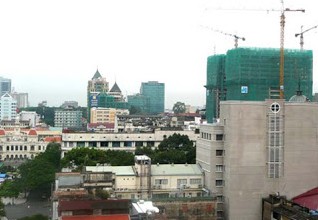
Now in 2009, many new buildings were constructed and being constructed.

Traffic is now like Bangkok 20 years ago.
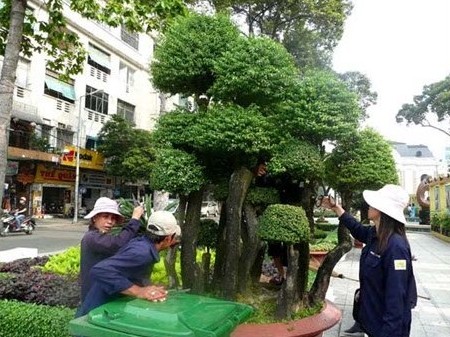
Now, serious efforts are being paid to keep the town presentable.

As a result, the city looks very charming these days.
Hanoi
A similar transmutation took place in Hanoi, but the extent of metamorphosis is actually greater in Hanoi because Hanoi in the 1980s was somewhat dismal place.

A typical Hanoi building in 1989
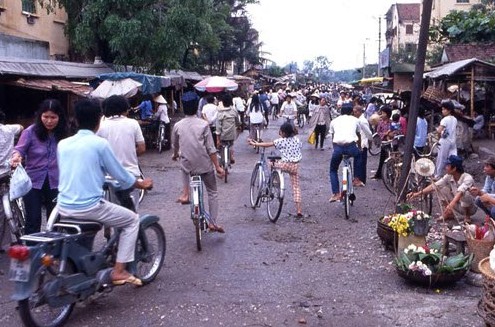
A Hanoi street in 1989

Hanoi outlook in 2009, it is quite an attractive town.
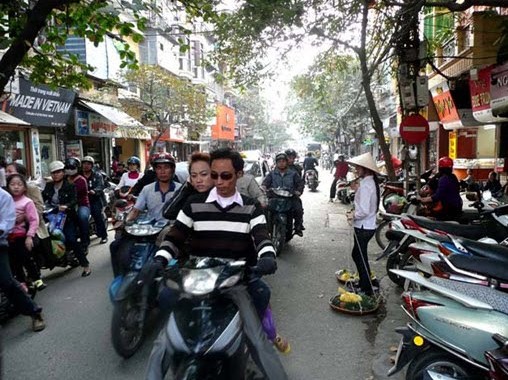
Hanoi street is less noisy and probably more cultured than HCM (2009)
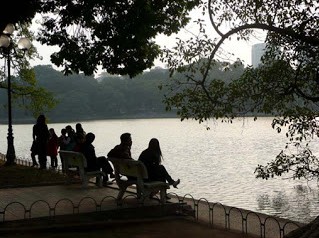
Relaxing at Hoan Kiem Lake in Hanoi (2009)
People (South)

Children and housing in Bien Hoa near Ho Chi Minh city in 1988

Moon cake factory in Ho Chi Minh city in 1988

Busy street in Ho Ch Minh city in 2009
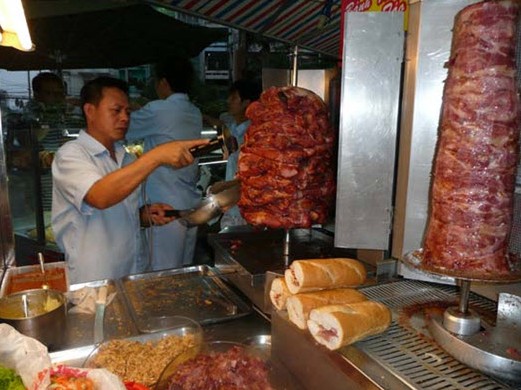
Barbecue shop in Ho Chi Minh city in 2009

Children and mothers attending an art class in Ho Chi Minh city in 2009
People (North)
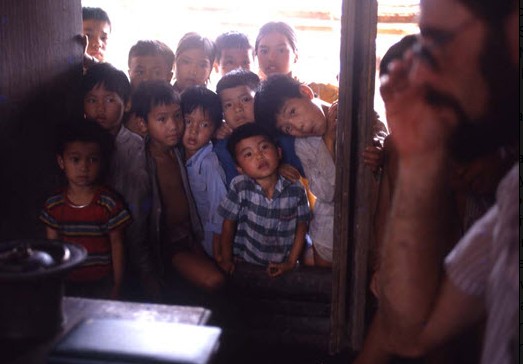
“Curiosos”; When we visited Hanoi in 1989, just the presence of Reinhardt Howeler caused quite a sensation.
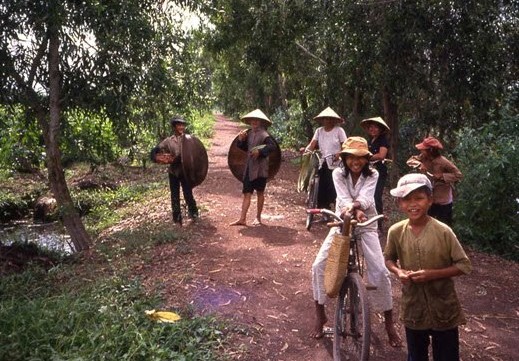
Farm people near Hanoi in 1989

Children in cassava field near Hanoi in 1989

People in front of Mrs. Sau’s house in Hatay, near Hanoi in 2009; Successful lives change many things.

People relaxing on the bridge at Hoan Kiem Lake in Hanoi in 2009

Hanoi street shop in 2009; Westerners are no longer a curiosity
Shops in Ho Chi Minh city (more pictures including)
- Ben Thanh Market in the center of Ho Chi Minh city in 1988
- Inside the Market
- Cassava sold in open market in Ho Chi Minh city in 1988
- Market in 2009
- Bread shop in HCM street in 2009; the cheapest one is \15 and the most expensive one is \50 (US$0.55)
- A super market
- Yet, outside HCM, this type of a small, traditional operation is still common; A movable shop near Bien Hoa in 2009
- Shops in Hanoi
- Hanoi market with children in 1989
- Money changers in Hanoi street in 1989
- Hanoi street shops in 2009
- A toy shop in Hanoi in 2009
- A department store in Hanoi in 2009
Book store in Ho Chi Minh city
- As was expected, there was hardly any book store worthy of mention in my first visit in 1988. What I observed in this visit in 2009 follows:
- The main section of a big book store
- Children book section
- Stationary section
- I was most impressed with the good quality maps printed in Vietnam being sold at very reasonable prices
Noodle shops
When I first visited Vietnam in 1988, there was hardly any restaurant, in many places not even an eating place for pay, outside Saigon. All our itinerary was managed by the “Liaison officer” of the Government office in charge of foreign visitors and all the eating outside the big cities was officially arranged. The choice and the quality was predictably unimpressive at that time.
- I was to witness a tremendous change in eating in this visit in 2009.
- For shop in Hanoi
- The renowned “Fo”
- Market noodle shop in Ben Thanh Market in Ho Chi Minh city
- A super deluxe version of cassava noodle “ラーメン” at \250(US$2.75)
- Vietnam has caught up with Thailand in this type of ordinary eating; “Fo” is quite comparable with “Bamie Nam” of Thailand
- Vietnam is the No.2 exporter of coffee next only to Brazil overtaking Colombia. As such, the Vietnamese coffee is good as ever, together with the Vietnamese bread,
Hotel
I described about the state of a government-run “hotel” where we stayed in May 1989 as follows; “Yet, we had worst experiences when we traveled outside big cities. When we decided to stay in the city of Phan Rang about 350km to the northeast of Ho Chi Minh city, the new privately run hotel was all full so that we had to stay at the government run hotel. The government hotel occupied a large lot in which the sleeping quarters were 100m away from the eating place. Not a single soul was staying at this vast place on that night. I suspected no one had stayed for the past three months at least. The room was full of spider webs and dung of wall lizards and inevitably very dirty. There was no air conditioning or private toilet. A naked bulb was the only illumination and the door knob must have given out some 15 years ago and a huge pad lock had replaced it. The towel was provided but its original color was indiscernible. Many cockroaches were running in the communal bath room in which the toilet was full of rubbish and never flushed. An about 5cm rubber hose connected to the water faucet was the only shower facility (actually it worked very well; the only thing I liked of this ghost house. I was rather refreshed after suffering from all these pandemonium). The whole atmosphere suggested how a prison cell would look like. The whole setting was in good contrast with the private run hotel which was smaller but filled with guests and maintained a cheerful atmosphere. This was in the South. Things were worse in the North.
Yet, the most appalling part was the payment. The attendants, all elderly women, charged each of the Vietnamese colleagues an equivalent of US$1.75 in local currency, which was not particularly high for our understanding but paying an equivalent of 1.5 day wage for this accommodation was disputable. By regulation, they charged each of us US$27.50 in hard currency. In China, foreigners usually have to pay twice as much as native Chinese for air tickets, train tickets or hotel accommodation. For the domestic air tickets of Air Vietnam, foreigners have to pay four times as much in hard currency. Yet, this time it was 15 times as much. The attendants were showing the faces of incredulity. Anyone paying money for staying in this place was surprising enough. It must take foreign idiots to pay two month salary of local people for staying in this miserable place. Something is grossly wrong with the economic system. It is a tragedy that more than ten years was necessary to realize that.”Everything changed during the past 20 years, of course. Yet, it is in the hotel situation where the change can be seen most dramatically.
- Hotel buildings in Ho Chi Minh city in 2009
- Breakfast at Saigon Oscar Hotel where I stayed for three days in Dec 2009
Yet, the most impressive is the change in people’s attitude toward service and responsibility. I carelessly left a bag containing some memory cards and a recharger in my room at this Saigon Oscar Hotel. I realized this when I arrived in Hanoi but it was too late. Only half expectedly, I called the hotel from Yamatedai, Japan informing about what had happened. The hotel attendant answered that they were keeping the item in their Lost-and Found section. I immediately sent a Fax asking them to send the bag to my address in Japan. To my delight, the bag arrived in Yamatedai in good order a week later. I found it fair to inform this rather pleasant experience in some travelers’ Blog (口コミ旅行情報) as follows;
HUNG LOC AGRICULTURAL RESEARCH CENTER
In addition to the recognition, promotion and social success of my former colleagues such as Hoang Kim, Nguyen Huu Hy, Trinh Thi Phuong Loan and Tran Ngoc Ngoan, the upgrading of the institutions where we used to conduct the varietal improvement work together is another very pleasant side product of our collaboration.
We (Reinhardt Howeler and myself) started with this type of formal, if not stressful, negotiation on how we would conduct our collaboration at Hung Loc Center in 1988.

Even as late as in 1992, the meeting was not without some tenseness.
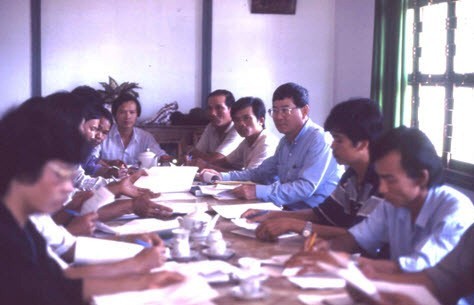
Hung Loc Center was a rather sleepy, smallish place typical of underdeveloped countries (1990)


Harvested cassava roots from the experimental plots were carried by this type of “Truck” to the nearby processing place, circa 1992.
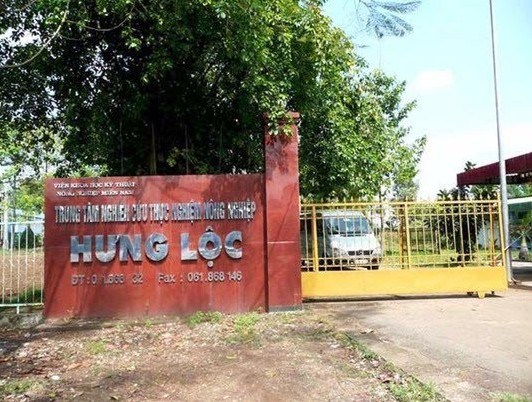
To my delightful surprise, Hung Loc Center in 2009 is a quite different place.
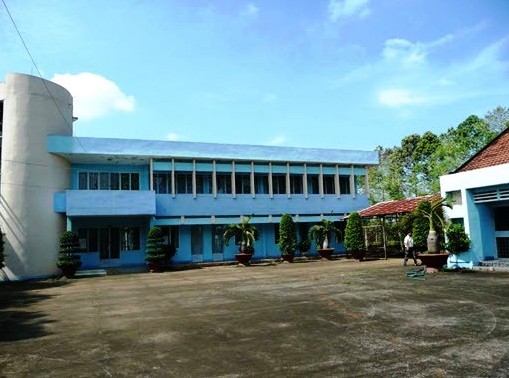
New building at Hung Loc Center in 2009

Meeting old friends in front of the meeting hall at Hung Loc Center in Dec 2009.
AGRICULTURAL COLLEGE No. 3 TO THAI NGUYEN UNIVERSITY
When we first visited North Vietnam in 1989, Thai Nguyen was a rather uninspiring rural town where the only higher education institution was a small college called Agricultural College No.3. Several students hanging their laundry at their dormitory was about the only memory I got in my first visit to AC3.

AC3 campus in 1994. Children beside the cassava experiment field inside the AC3 campus in 1994

Thai Nguyen University campus in Dec 2009 (The former AC3 was upgraded to a university housing more than 10,000 students)
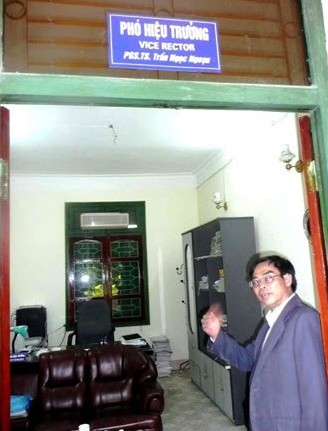
My dear friend Ngoan is now Vice Rector of Thai Nguyen University
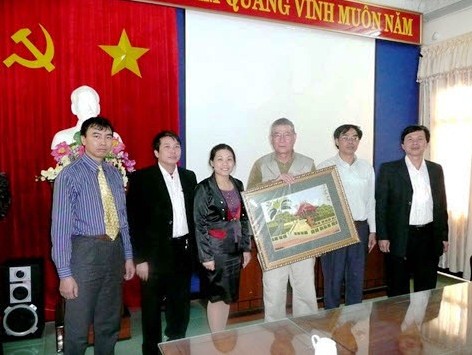
Receiving a gift from the University in Dec 2009
VARIETAL IMPROVEMENT
Varietal Improvement in the South
This is, of course, the core of the story. Since much has been reported in formal papers, I am herein just showing some photos for remembrance.

The first bulk harvest of KM-60 (right) compared with the local variety, probably HL-23 (left) at Hung Loc Center in 1991.

KM-60 (left) and the local variety HL23 (right) with KK and Kim at Hung Loc Center circa 1993.

Director Hoang Kim standing contentedly with KM-94 (right) and the local variety HL23 (left) at Hung Loc Center circa 1993.

KK with colleagues at KM-60 field in Dong Nai in 1996
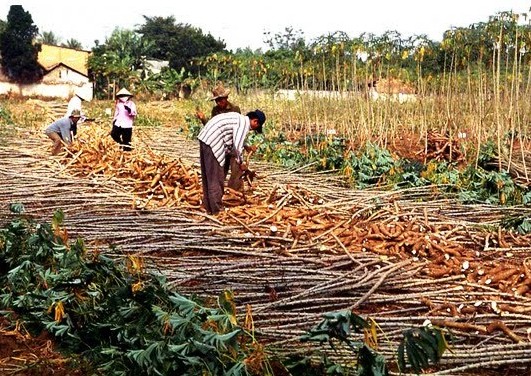
Harvest of new varieties from Thailand at Hung Loc Center in 1997.

Multiplication of a new variety from Thailand at Hung Loc Center in 1997.
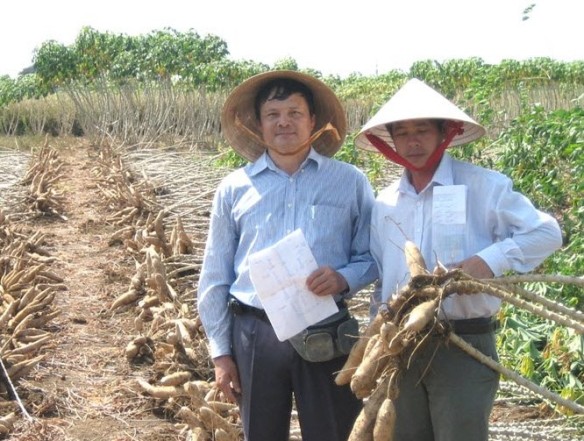
New variety KM98-1 at Hung Loc Center in 2000.

Good planting of KM 98-5 in Tay Ninh in 2009.

KK and Kim in Tay Ninh at KM 419 field in Dec 2009.
Varietal Improvement in the North

Ngoan and KK in a varietal trial field in Bac Thai circa 1995.

KK and farmers near Pho Yen in 1997.
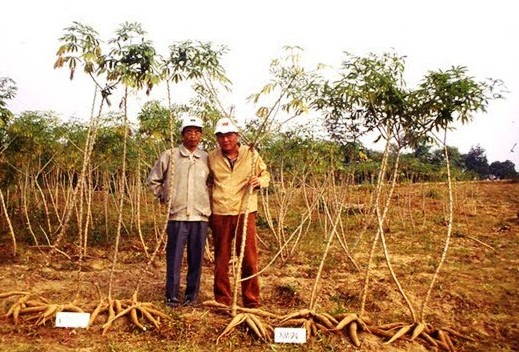
Local variety Vinh Phu (left) and KM-94 (right) with Ngoan and KK at AC3 experiment field in 1997.

Local variety (left) and KM-60 (right) in Hatay in 1996 with Loan at the center with a TV crew.

A new selection KM-95-1 (left) and the local variety Vinh Phu (right) in Hatay in 1997 with Director Ho on the left.

A group photo taken at the experiment field in Hatay in 1997. Faces of Ho, Loan, Mr. Tat, Mrs. Sau, Mrs Quyen among others.
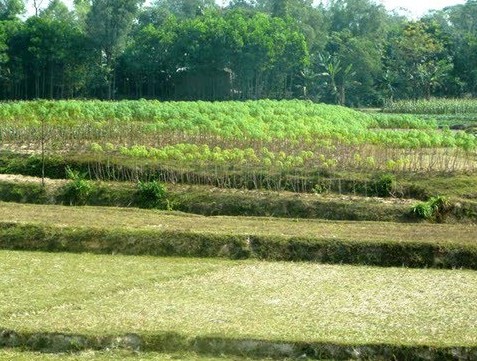
Cassava field near Pho Yen in Dec 2009.
Ngoan (Professor and Vice Chancellor), Mr. Kien (a dedicated farmer), KK, and Loan (Retired Deputy director) at Mr. Kien’s cassava field near Pho Yen in Dec 2009.
READINESS FOR WORKING WITH FARMERS
One thing outstanding in our collaboration with the Vietnamese colleagues is their acute readiness for working closely with farmers. This is in good contrast to my Latin American experience.

Cassava field near Hanoi, circa 1995. Loan, a farm wife, KK and Ho.

Hearing from farmers in Hatay in 1996. KK and Mr. Chien, Deputy Director of Root Crop Research Center, VASI.

Loan leading a town meeting in Hatay in 1996.

Ngoan presiding a village meeting in Pho Yen in 1996.

Harvest of a field trial in Bac Thai in 1996; a curious mixture of Ngoan (Professor to be), students, farmers, an old woman and a baby.

Reunion at Mr. Kien’s house in Pho Yen 13 years later.

Strangely absent from my photo collection is Hoang Kim. Kim is the undisputed champion of associating with fellow researchers from other institutions, farmers from many provinces. Kim initiated the invitation of advanced farmers to the selection field at Hung Loc Center so as to evaluate and select their own favorites; a harbinger to the later much celebrated “farmer participatory research.

Here in 2009 in Dong Nai and Tay Ninh cassava field, Kim is mixing with advanced farmers, students, extension staff and officials.
SUCCESSFUL FARMER
I: Mrs. Tran Thi Quyen, Hatay
Here are the portraits of some successful farmers who had improved their lots remarkably utilizing the new cassava varieties.
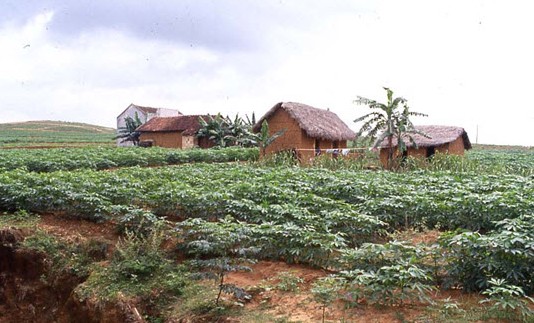
Typical cassava farmers’ houses seen in our 1989 visit in North Vietnam.

Mrs. Tran Thi Quyen was one of those cassava/pig farmers in Hatay Province who had first adopted KM-60, With the better harvest of the new variety, she could increase the number of pigs she could sell to the market. This was the new house she was building using the money she earned and saved, which she was proudly showing me in my 1997 visit. The house was complete with a kitchen, toilet and bathroom under the single roof and cost some \80,000 (US$700) at that time.
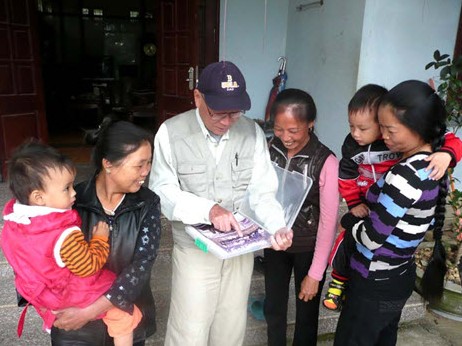
Mrs. Quyen (left) with her grandchild in our reunion in Dec 2009.

Mrs. Quyen is still growing cassava and pigs. She is now building a new much bigger house.
II: Mr. Ngo Trung Kien, Pho Yen
Cassava was a small farmers’ crop used for family pig feeding or sold to small noodle factories.

Cassava chips drying on the road circa 1994.

Cassava and pig in North Vietnam before the introduction of new varieties.

Cassava noodle drying near Hanoi in 1989.
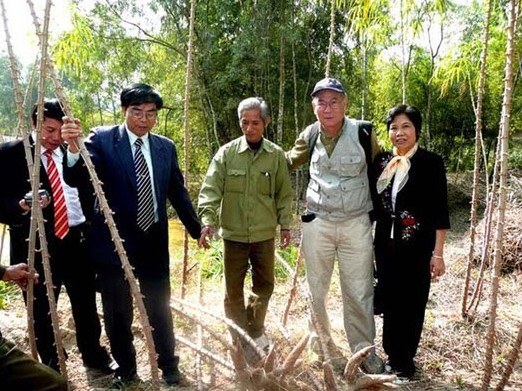
Mr. Ngo Trung Kien of Pho Yen, Bac Tay Province a dedicated farmer and one of the earliest adopters of KM-60. He has been successful in expanding his cassava/pig farming. Here in his plot in 2009, he was planting KM-98.

Mr. Kien is a innovative farmer as well. He introduced feeding chickens with cassava.

Pig feeding continues as ever. Mr. Kien told us he could now sell more than 50 mature pigs to the market annually.

Meeting village people at Mr. Kien’s house, Dec 2009. He has taught all his techniques to other farmers in the same village. Many farmers have built new houses and virtually all families own a motorcycle these days.
III: Mr. Tong Quoc Thanh, Tay Ninh
Mr. Tong Quoc Thanh of Tay Ninh Province was one of the earliest adopters of KM-60 promoted by the erstwhile Director Hoang Kim of Hung Loc Center. He was reputed to have made a lot of money by the multiplication and the sales of planting stakes of KM-60 and later KM-94. Either because he is a shay man by character or he is afraid of the Tax Office, Mr. Thanh does not elaborate too much about his success especially on the money making. Nevertheless, by any standard Mr. Thanh is a vastly successful man and the extensive cassava planting of his own cannot defy the reputation.

Mr. Thanh uses KM98-5, KM440 (tai xanh) and KM419 (tai do, cut lun) for intercropping with rubber tree, Tay Ninh in 2009.

KM-94 is still the best for mono-culture cassava in Tay Ninh, Mr. Thanh agrees. But he is planting KM98-5 (tai xanh) and KM419 (tai do) extensively in his field, probably because being a new variety, KM98-5 and KM419 still offers good opportunities for planting stake sale.
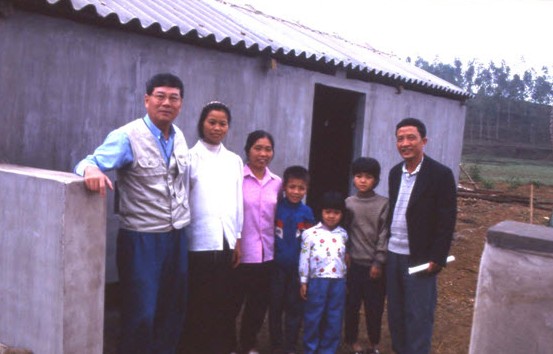
V: Mrs. Nguyen Thi Sau, Hatay
… When we visited Mrs. Sau in 1996, she showed us her new pig pen; KK, Mrs. Sau, Mrs. Quyen, children and Mr. Tat (Extension office at Root Crop Research Center, VASI).
In 1997, Mrs. Sau was very proud of posing in front of her new house and motor cycles. I heard the house cost some equivalent of 250,000 (US$2,000) at that time.

Loan, Chien, Mrs. Sau’s husband (working in the Municipal office), Mrs. Sau and Tat.
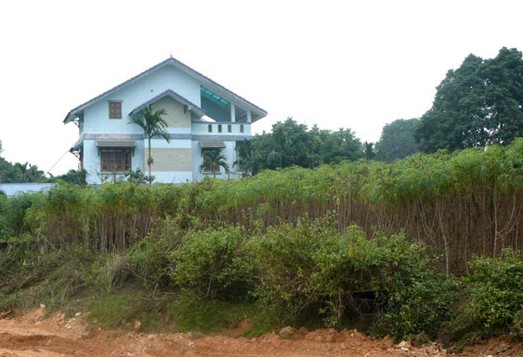
Mrs. Sau’s new mansion in 2009.


Front view of Mrs. Sau’s mansion.
Sala of Mrs. Sau’s mansion.

With the expansion of Hanoi city area, Mrs. Sau’s place is now much urbanized. Being a small but smart “entrepreneur”, Mrs. Sau is now President of a mineral water production and distribution company.
V: Mr. Ho Sau, Trang Bom
At the time of our first visit in 1988, Trang Bom, one of the fiercest battle fields of Vietnam War, was not much more than a sleepy little town.

Mr. Ho Sau, who lived next door to Hung Loc Center near Trang Bom and Bien Hoa, was the first farmer to be invited to Hung Loc Center to observe the harvest of a cassava varietal trial which included KM-60. He quickly decided to multiply the small sample stakes of KM-60 for his own planting and later for sales to other farmers. Mr. Sau, 2nd from left, was a celebrated participant to the Workshop held at Hung Loc Center in 1997.
Mr. Sau’s cassava Palace in 2009. Mr. Sau is now an enormously successful business man owning large cassava plantings, a couple of cassava processing plants and a trading company.
His garden is decorated with many wonderful objects. A sculpture carved from the root of a single tree.
Yet, the most imposing is the crocodile pool with a dozen or so crocodiles for display.

Mr. Sau is not a type to hide his success to the extent of being flamboyant. Yet, he is intent in giving opportunities to many kinds of people. He is building houses for less fortunate families in the same village. Here in this photo below, he provides land and facility for Prof. Kim and his students to conduct field experiments. As such, I was reminded of the Colombian Pablo Escobar. While Escobar was a bad guy drug king, Mr. Sau may be a good guy cassava king.

From right to left: Students of Nong Lam University, Prof. Kim. KK and Mr. Sau.
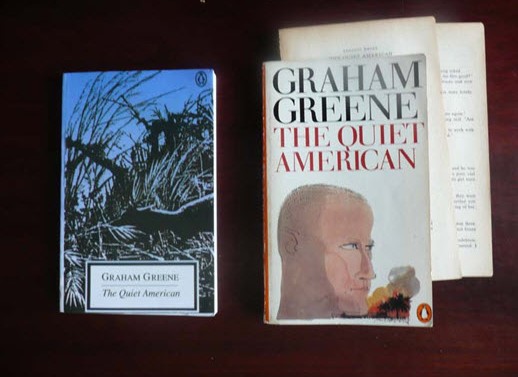
GRAHAM GEEENE [ THE QUIET AMERICAN ]
It was a delight to travel through Vietnam with 「The Quiet American」in hand. It was my third time to read this book. By the end of the journey, my paper back was nearly disintegrated. While I could not find this novel being sold in book stores in Ho Chi Minh and Hanoi, the street hawkers had a pirated version of the book. Honoring the hawkers’ smartness of finding the value of 「The Quiet American」as souvenir, I paid 80,000Don (some \400) to a hawker in Ho Chi Minh. In Hanoi, a hawker ran after me for some 50m offering the book for 50,000Dong.

Joy of reading 「The Quiet American」at The Continental Hotel.
Excerpts from 「The Quiet American」Graham Greene
P. 60, “I never knew a man who had better motives for all the trouble he caused.”
P. 74, “I was to see many times that look of pain and disappointment touch his eyes and mouth when reality didn’t match the romantic ideas he cherished, or when someone he loved or admired dropped below the impossible standard he had set.”
P. 94, “I laugh at anyone who spends so much time writing about what doesn’t exist – mental concepts.”
P. 103, “If somebody asked you what your deepest sexual experience had been, What would you say?” I knew the answer to that. “Lying in bed early one morning and watching a woman in a red dressing-gown brush her hair.” “Joe said it was being in bed with a Chink and a negress at the same time.”
P. 167, “He gets hold of an idea and then alters every situation to fit the idea.”
Plain as it is, this novel describes about the dark side of innocence. It is now profoundly touching that Greene had clearly manifested the impossibility of America winning a war against Vietnam as far back as in 1955.
In this vein, it is unsettling to find that this novel is regarded as a simple love story, if not a melodrama, in Japan, as can be seen in the following cut out from the major newspaper Asahi. It is somehow a part of our Japanese culture to reduce things to a minimum context, resigning to not seeing the whole.
DAVID HALBERSTAM [THE MAKING OF A QUAGMIRE]
David Halberstam is best known for his 「The Best and the Brightest」which was published in 1972 and became a world best-seller. His earlier book「The Making of a Quagmire], published in 1965, is less known but highly appreciated by some critics for much of the Halberstam’s perspectives on the Vietnam War originated from his experiences described in this book. I have been wanting to read this book ever after I read 「The Best and the Brightest」but the book was out of print for a long time. In one of many Internet notices from “Amazon” , of which I seldom pay serious attention, I found 「The Making of a Quagmire」was republished in 2008.

While 「The Best and the Brightest」is an in-depth analysis of Washington politics during the Johnson/ Nixon era, 「The Making of a Quagmire」is a ground level description of the local battles and politics in Vietnam during the Kennedy time. If 「The Quiet American」is a romantic narrative of innocence and complacency, 「The Making of a Quagmire」is a poignant account of ignorance and arrogance.

While「The Making of a Quagmire」contains all the reasons why America could not win the War in Vietnam, Chapter Six “Disaster: The Battle of Ap Bac” of this book describes, factor by factor, why the South Vietnamese/American forces could not win local battles in Vietnam. It is not that the Battle of Ap Bac was the turning point of the Vietnam War. It is remarkable because the Battle of Ap Bac contained all the elements why the Viet Cong/National Liberation Front could not be defeated.

If one reads 「The Making of a Quagmire」seriously, it should be transparent under the bright sun that this war could not be won by outside forces. Yet, Kennedy/Johnson Administration did not learn from the Pulitzer Prize (1964) of Halberstam in general and from the Battle of Ap Bac (Jan 1963) in particular. The North bombing by the US Air Force started in Feb 1965 and US Marines Corps were massively stationed at Da Nang in Mar 1965. History continues. As if nothing had not been learnt from Vietnam, and from 「The Best and the Brightest」in particular, the father/son Bush Administration went ahead with the Iraq and Afghan War on the same ignorance and arrogance. To human history, what is not learnt often outweighs what is learnt.
EPILOGUE
Throughout my many years of association with Vietnam, I have gotten to know many people, whom I seem to be able to categorize in retrospect. I got my first impression of the Vietnamese from the several Vietnamese trainees staying at the International Rice Research Institute, Los Baños, Philippines in 1963 and it was not particularly a favorable one. They appeared rather uncaring, cynical and apathetic, if not selfish, contemptuous, and corrupt. I may be too harsh and judgmental on them; nevertheless, Halberstam wrote about this type of people belonging to the upper strata of the South Vietnamese society during the same period so vividly and critically in 「The Making of a Quagmire」that my judgment might not have been too far away from the reality.
My ten years of close collaboration with my cassava breeding colleagues in the 1990s and the reunion with them in this trip completely changed my assessment of the Vietnamese. As evidenced by the series of my reporting here, they are industrious, insightful, considerate and indefatigable, as if to emulate General Vo Nguyen Giap. I might be a little too positively partial to those friends of mine. Nevertheless, I have a similar feeling toward some of my colleagues in Rayong, Thailand and Nanning, China to count a few. During the two decades of post-war Japan, we seem to have many Japanese of this category as well.
Then comes the mass of the population who just want tomorrow to be better than today. In this trip, I was deeply impressed and touched in meeting many people who seemed never to doubt tomorrow is better than today. This reminds me of the Japanese during the next two decades of post-war where the majority of the population was seeing a rosy future. Now in Japan, more than 30,000 people commit suicide annually and the main reason for this act is believed to be hopelessness to the present and future. Needless to say, Vietnam is not without problems such as the incompleteness of juridical system or rampant corruption to name some. Yet, the proportion of people feeling happy seems to be far higher in Vietnam than in Japan now. It is fascinating to imagine where these former colleagues of mine would further lead this society to.
People at a cassava open market near Hanoi in 1989.
People on a boat in Saigon river in 1988.
People on a ferry near Hanoi in 1989.
Boys on a Hanoi street in 1991.
Girls on a Hanoi street in 1991.
Two daughters at a village starch plant in Tay Ninh in1992.
People harvesting rice in Tay Ninh in 2009.
Hyper-energetic people in Ho Chi Minh city in 2009.
People relaxing at Hoan Kiem Lake, Hanoi in 2009.Chi tiết hình ảnh mời xem tại Source: https://foodcrops.blogspot.com/2012/09/cassava-and-vietnam-now-and-then.html
See more: Cassava in Vietnam: a successful story Thông tin tại https://hoangkimlong.wordpress.com/category/cach-mang-san-viet-nam/

| Nguồn tài liệu trực tuyến: Nhà sách Hoàng Gia |

CÂY LƯƠNG THỰC VIỆT NAM
Hoàng Long, Hoàng Kim (chủ biên) và đồng sự
http://fa.hcmuaf.edu.vn/hoangkimlong









